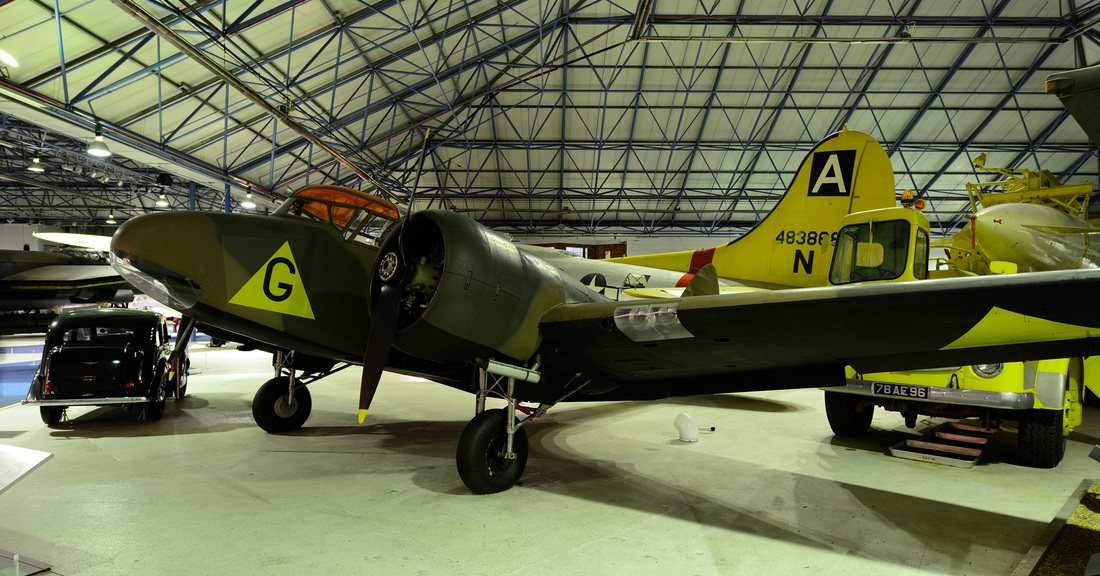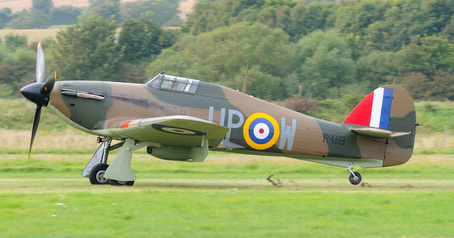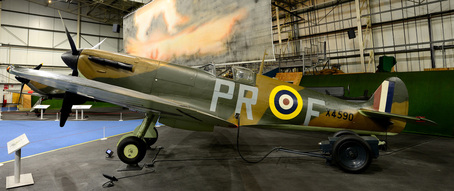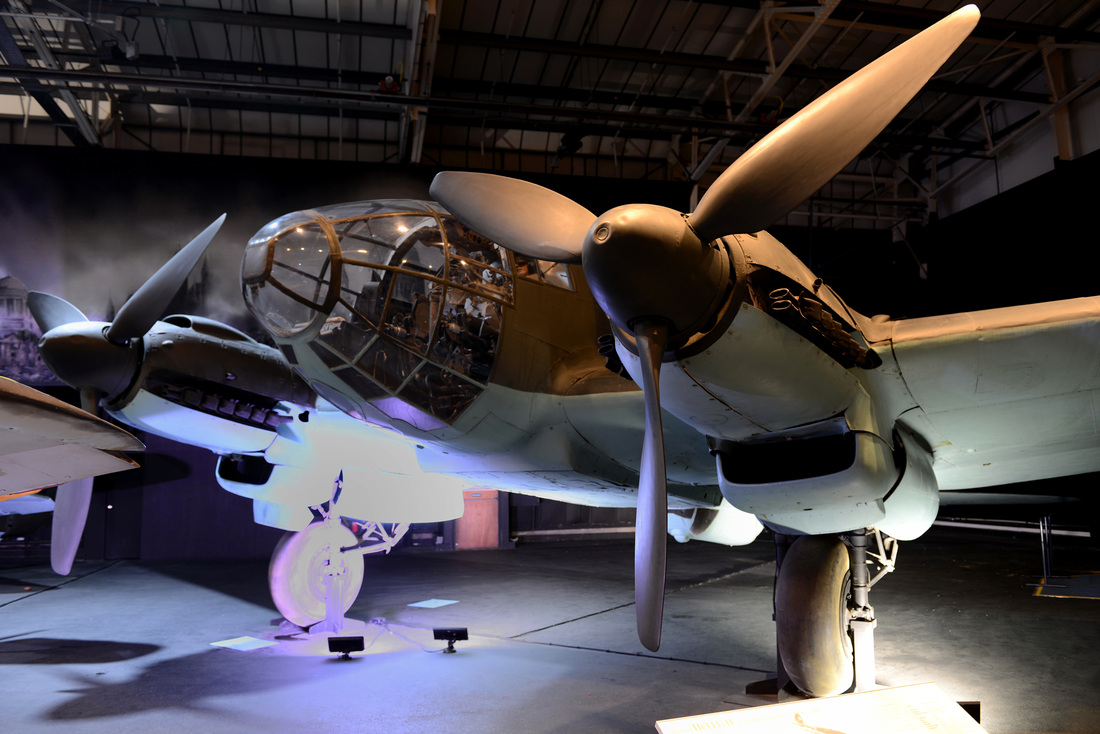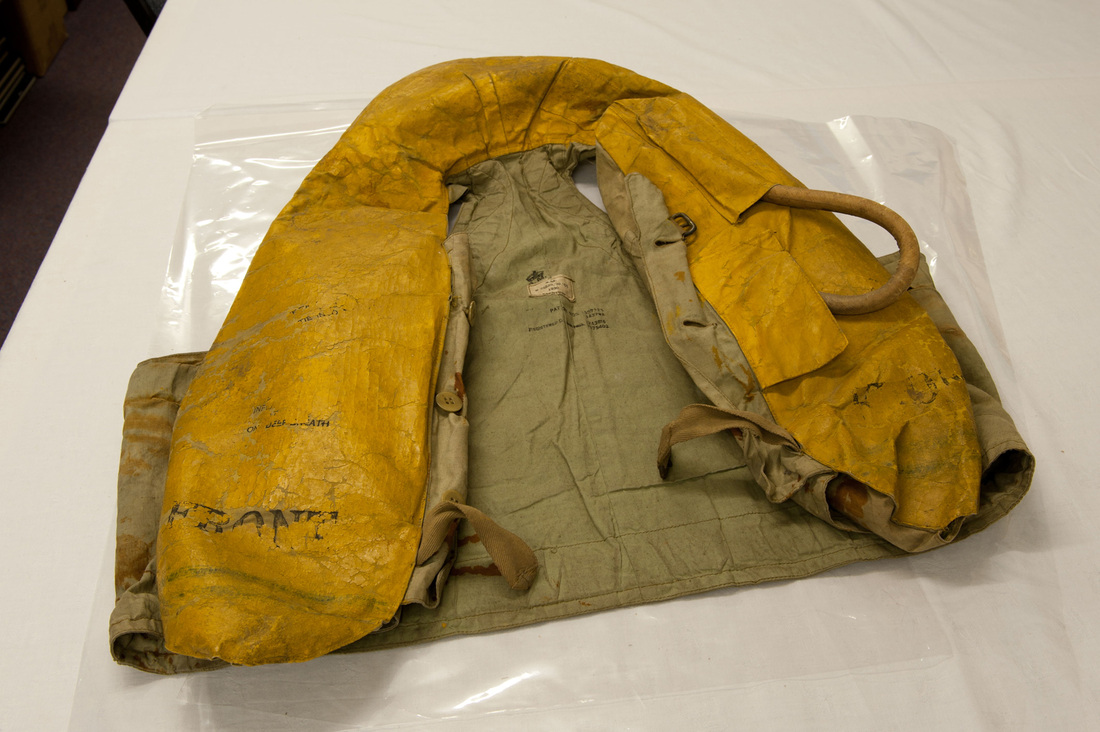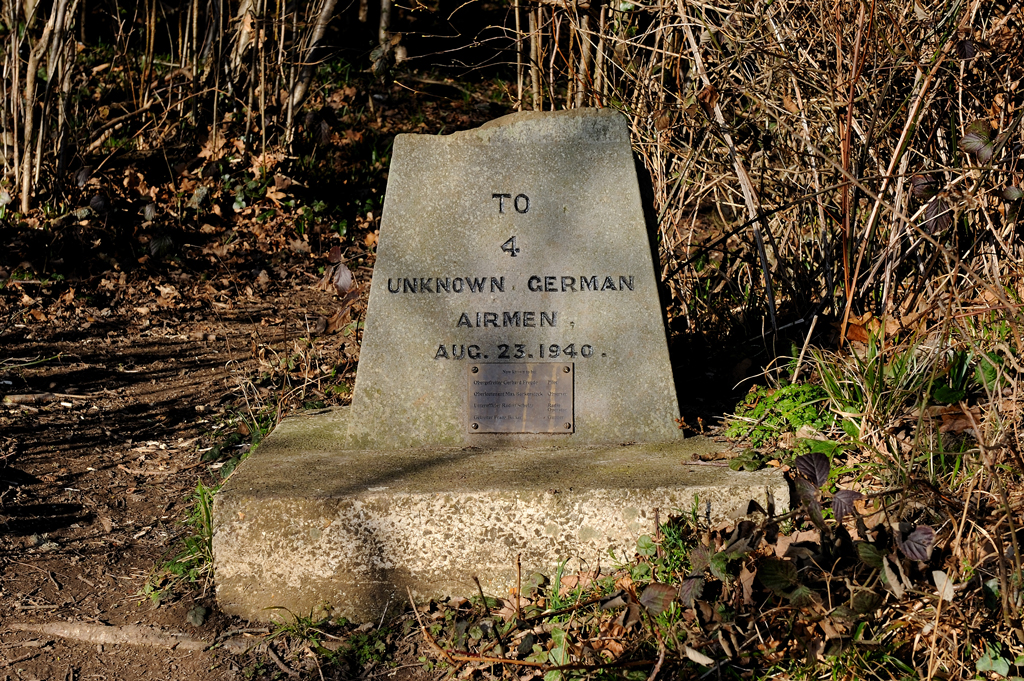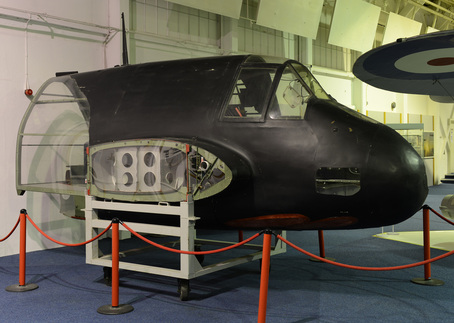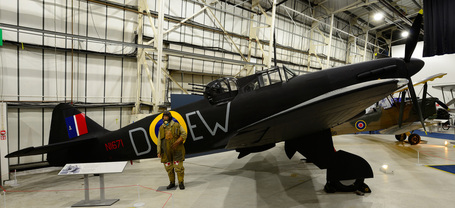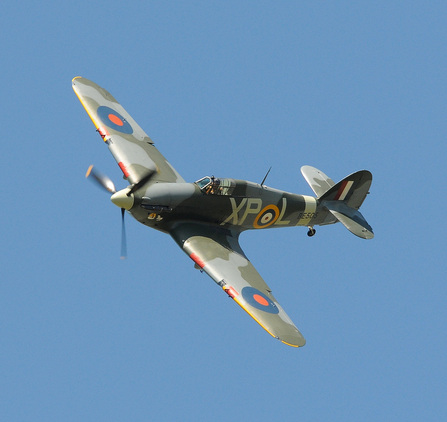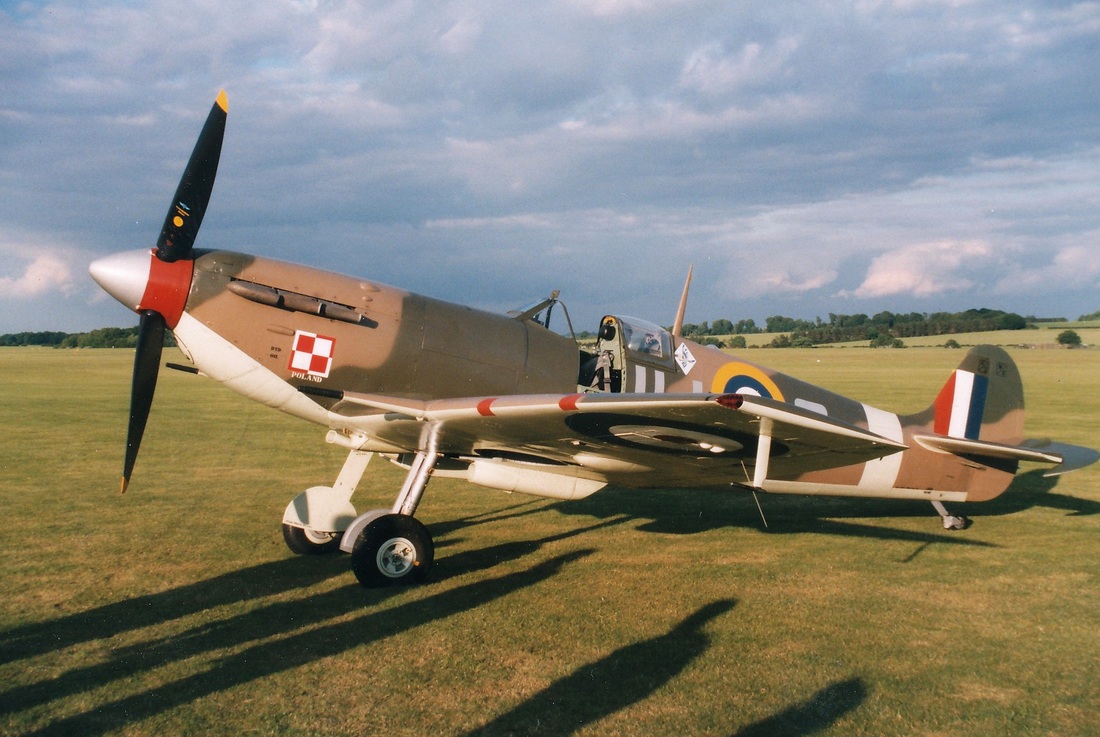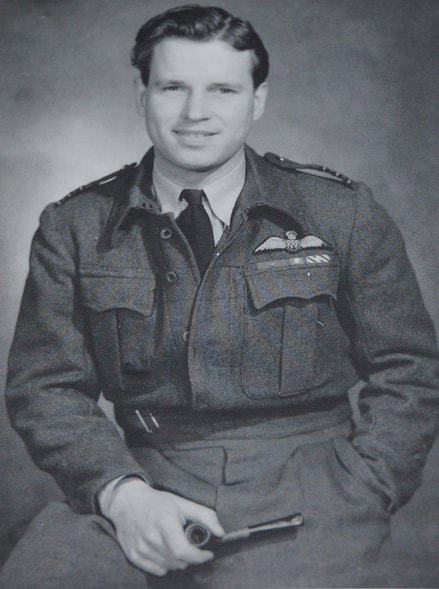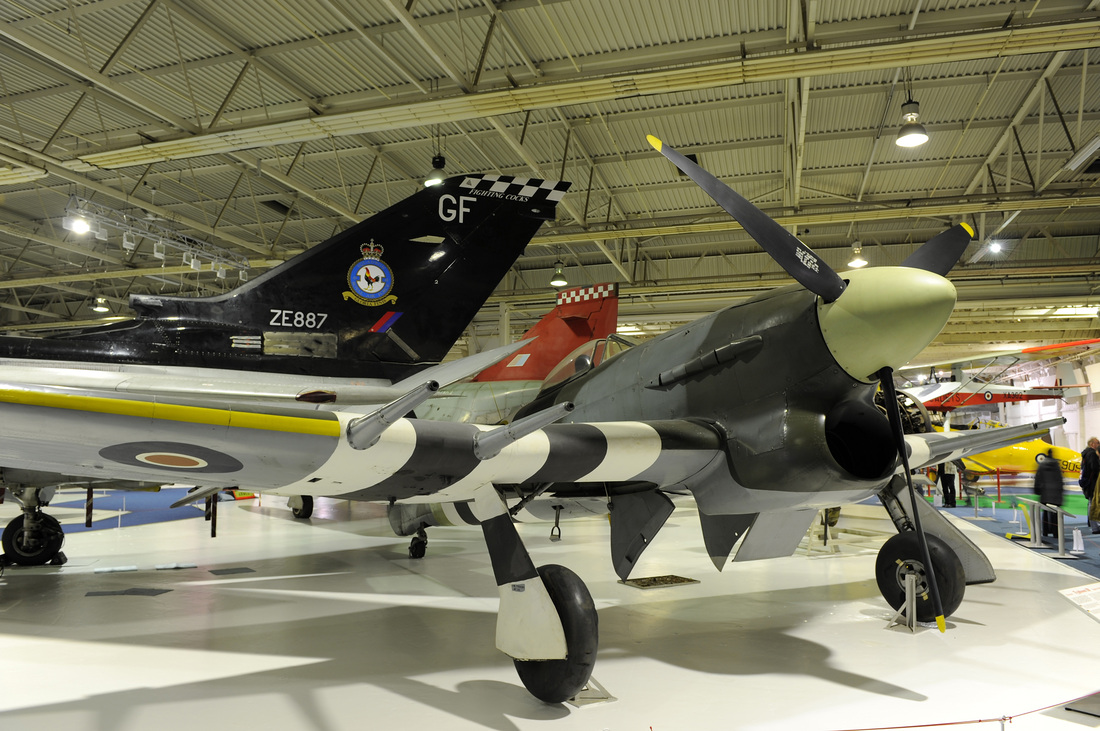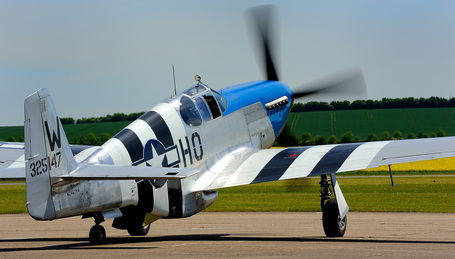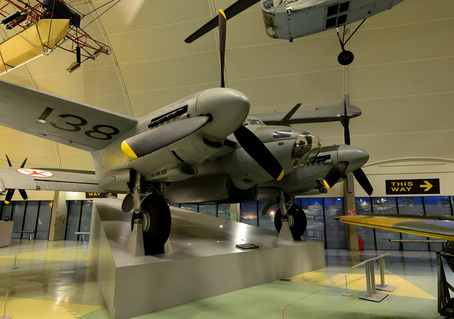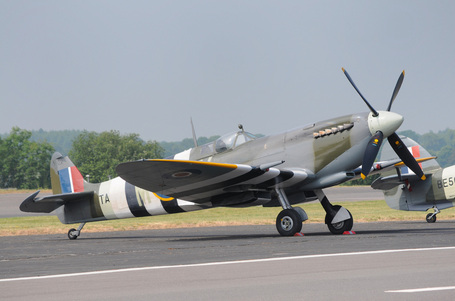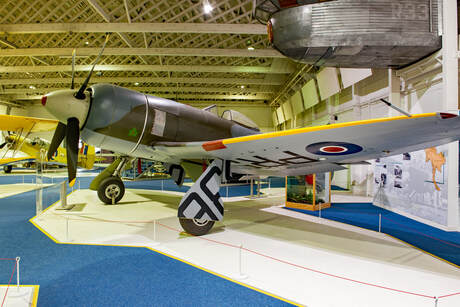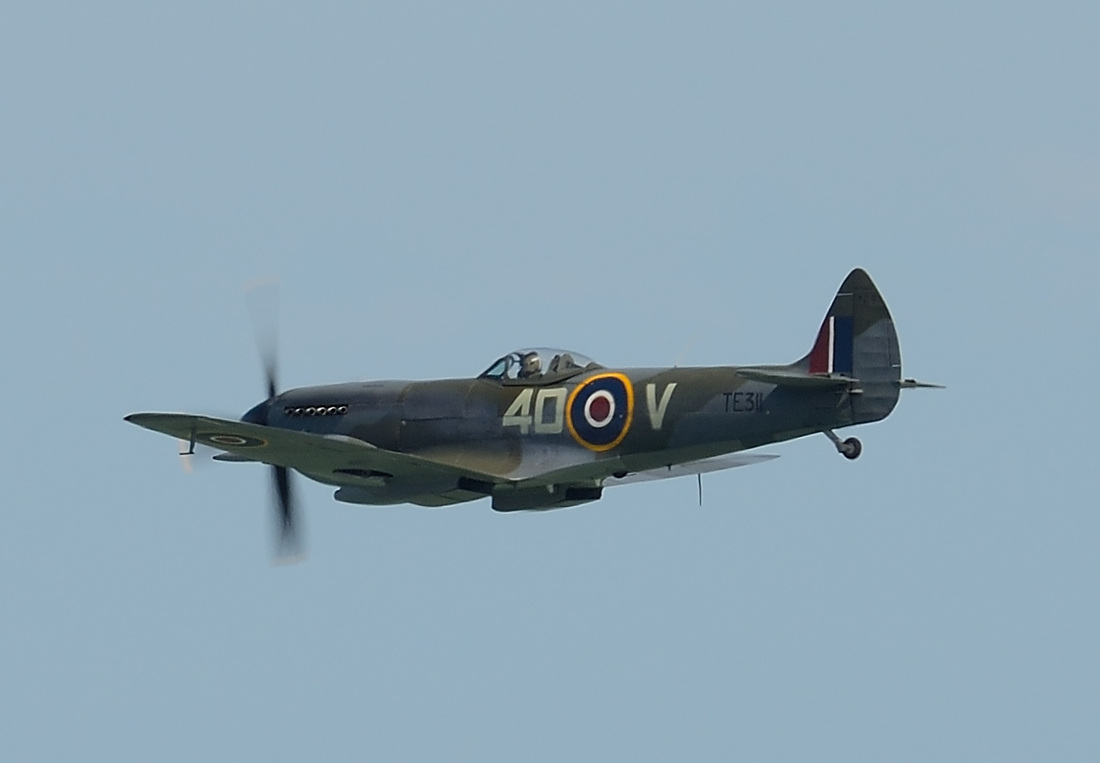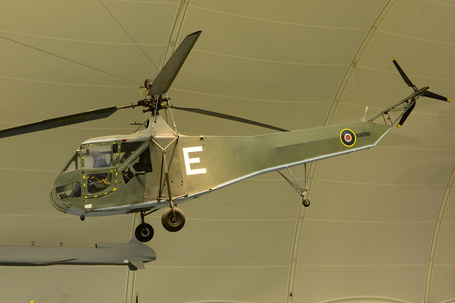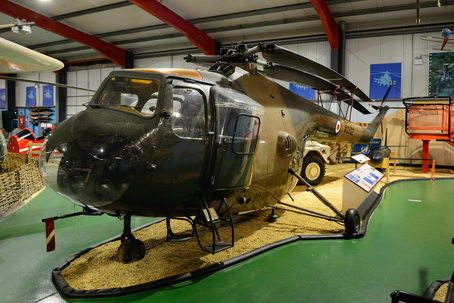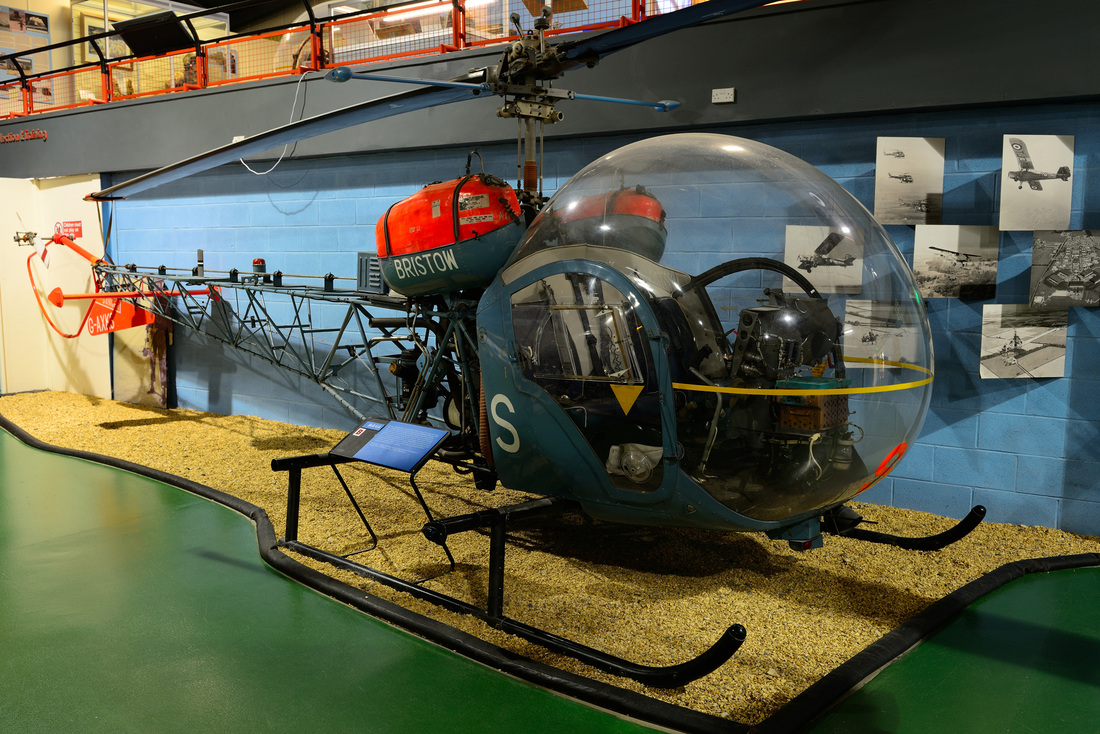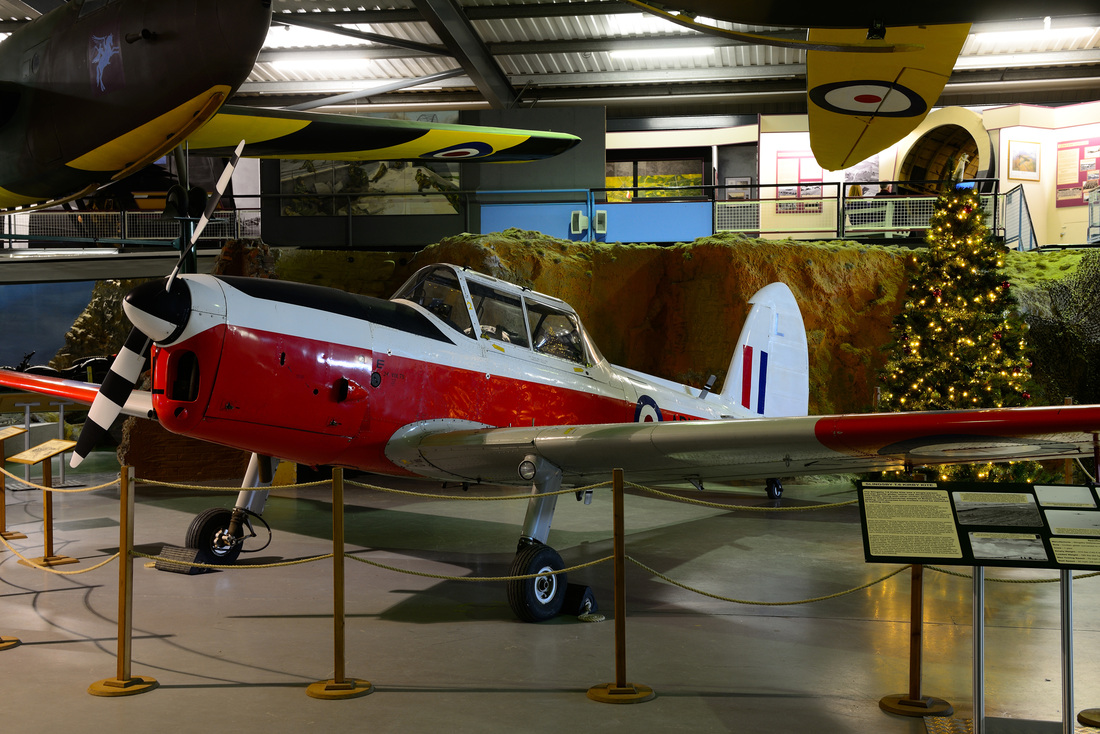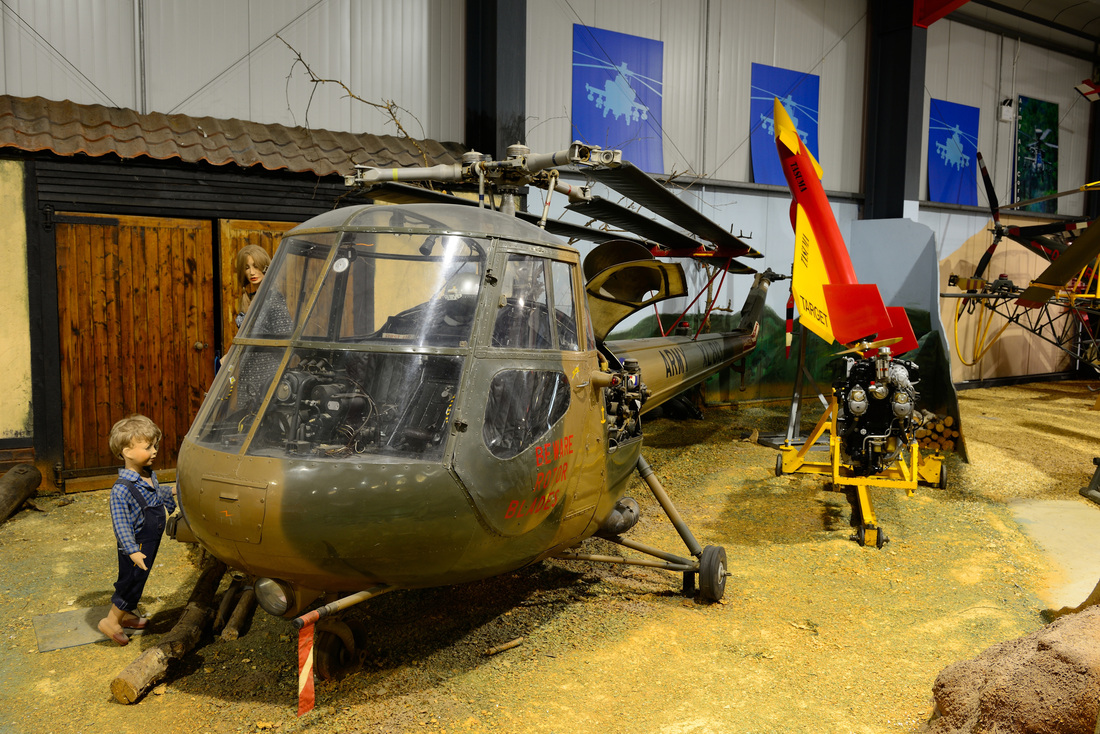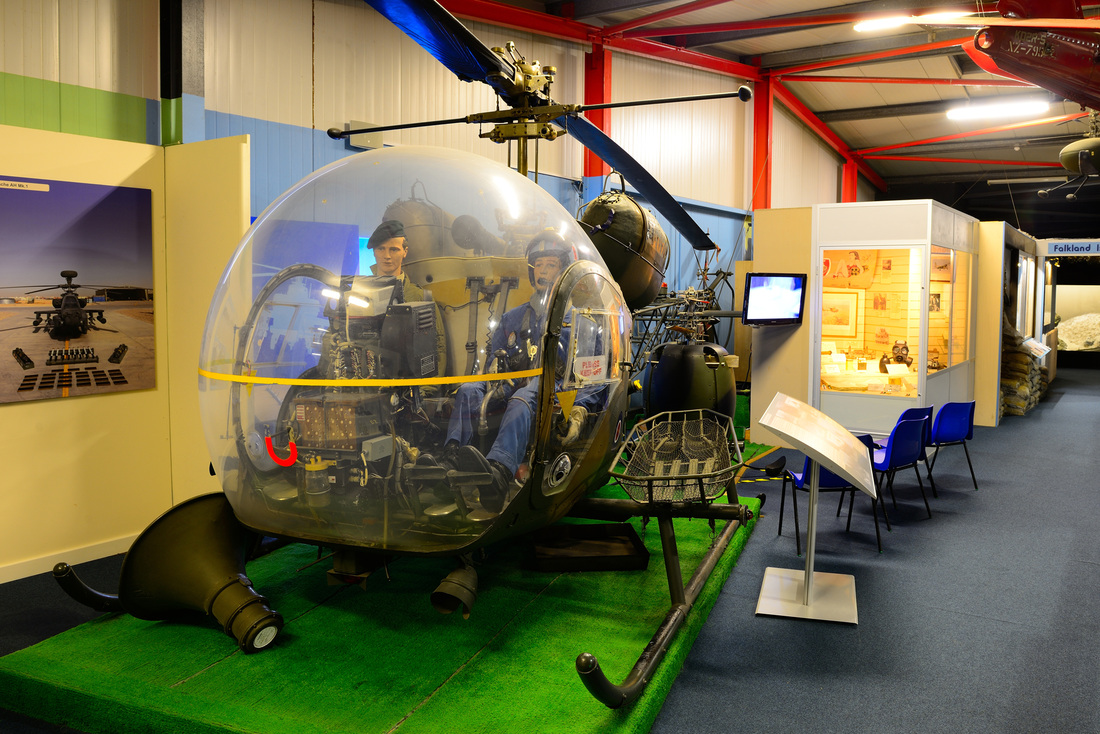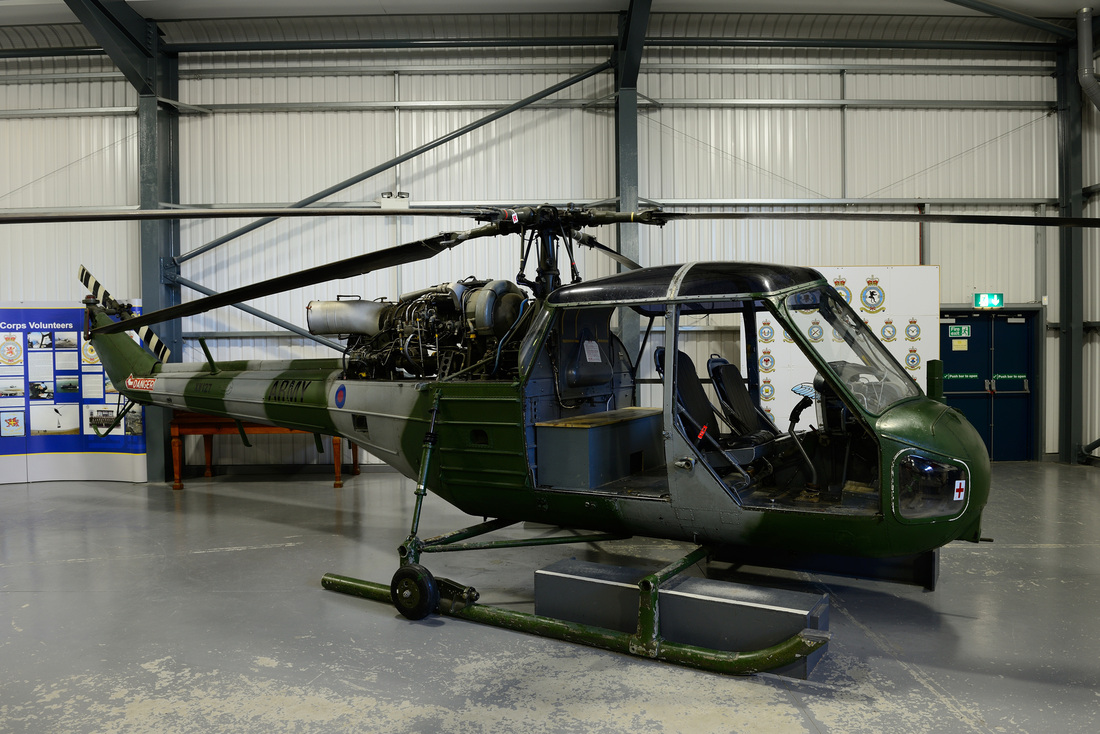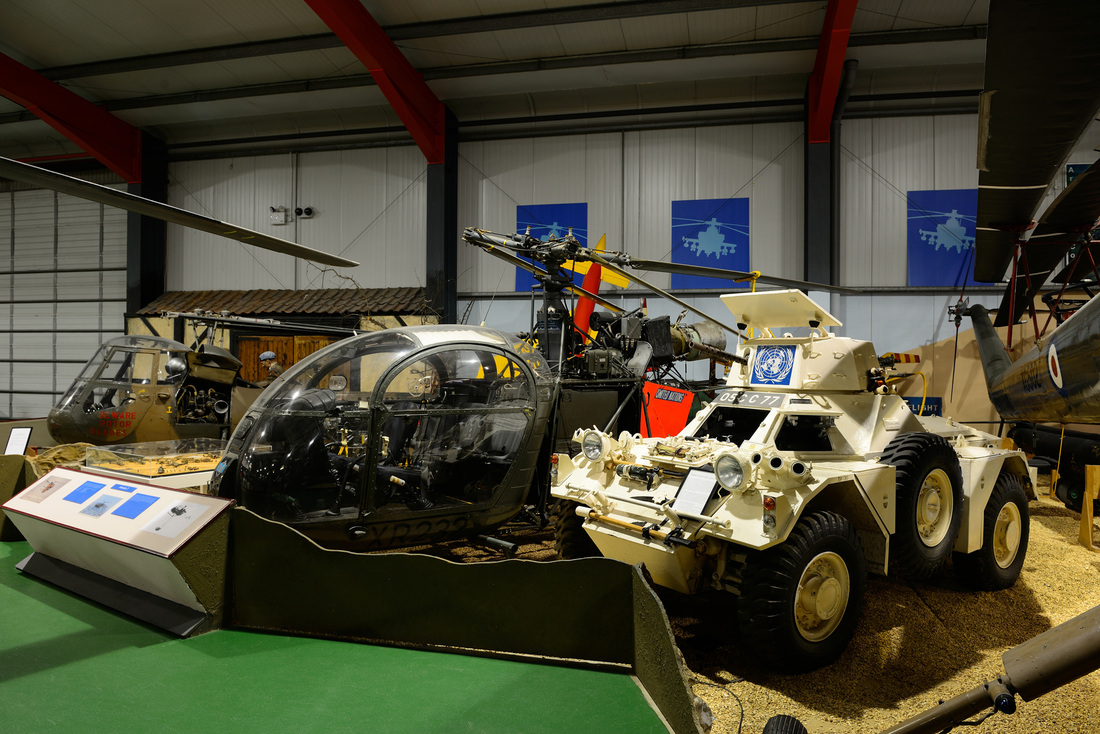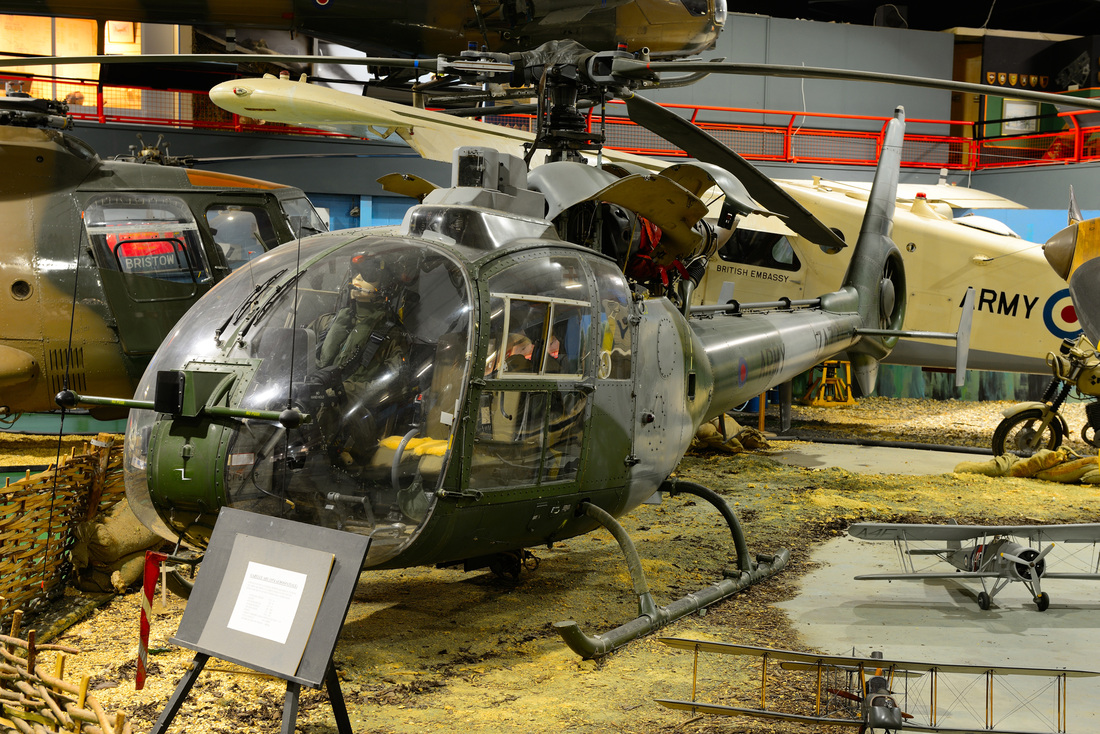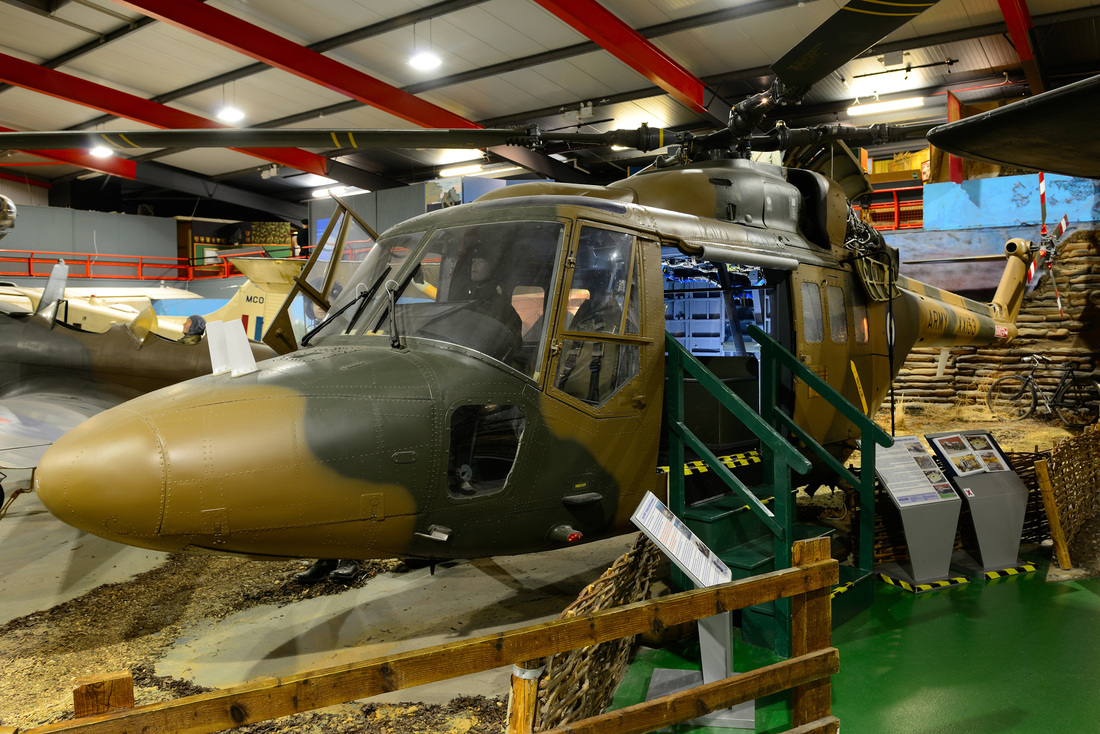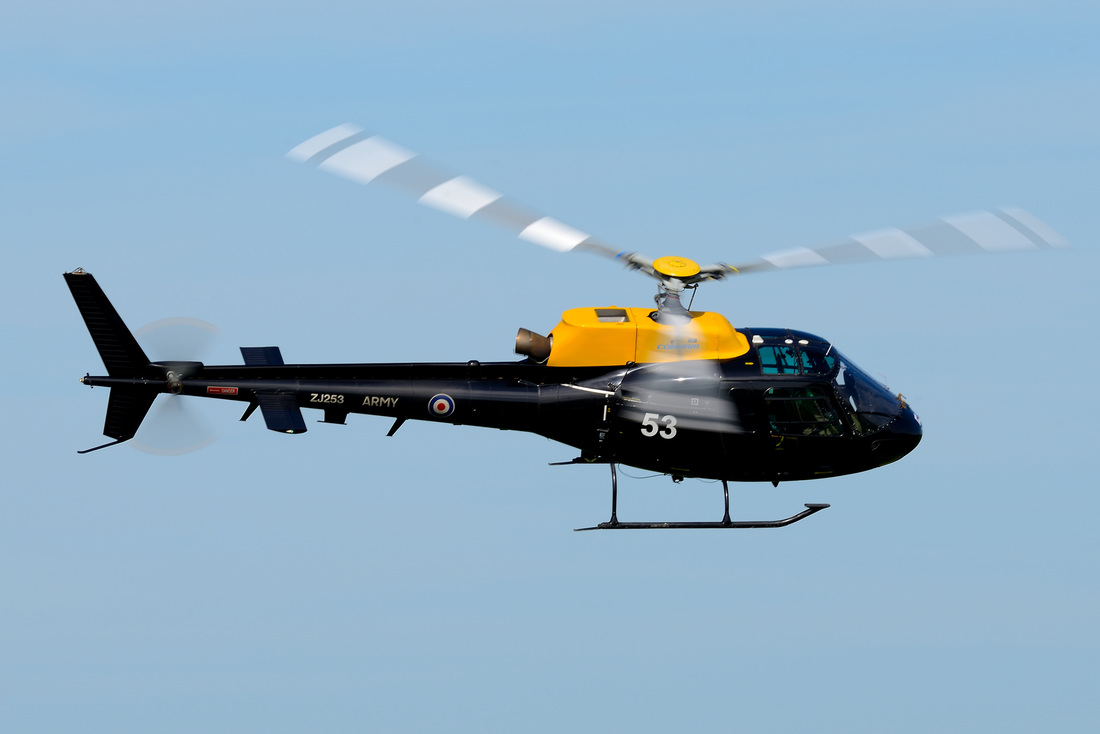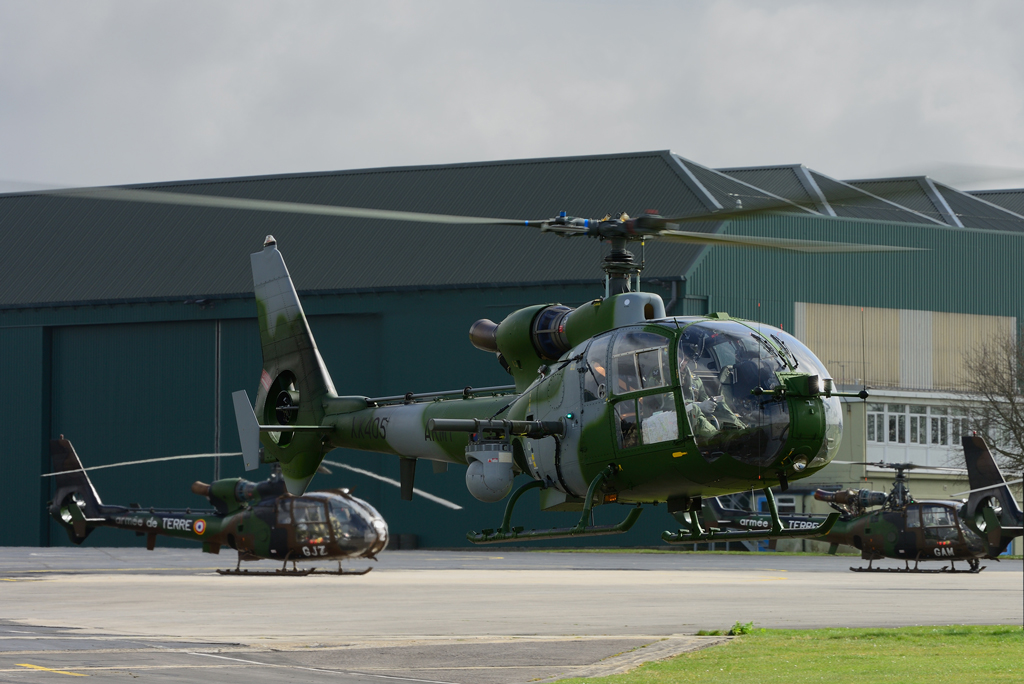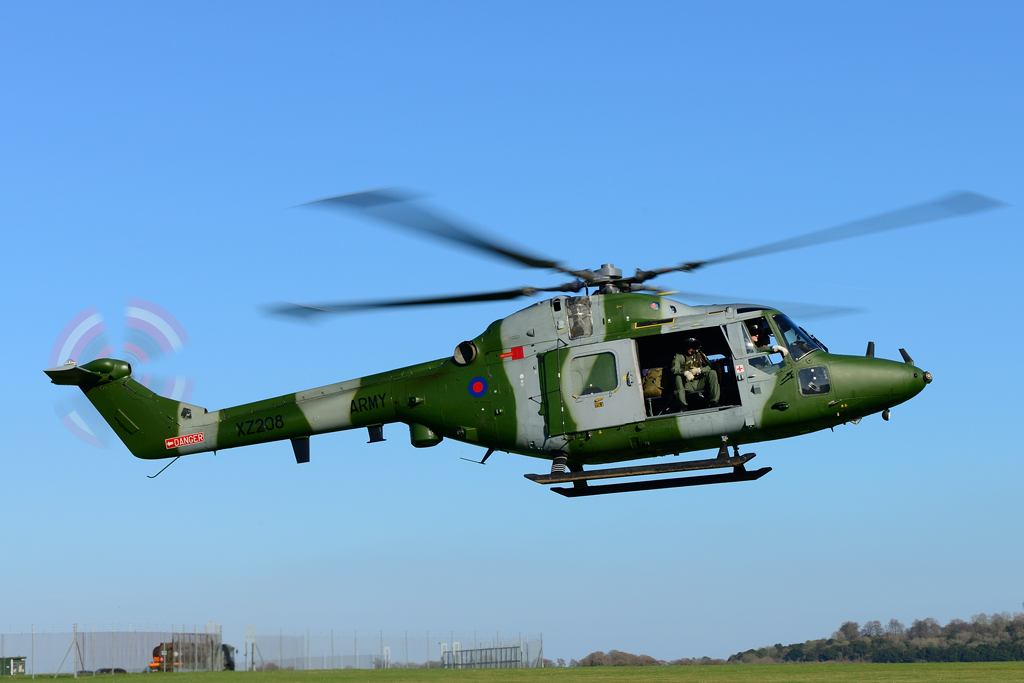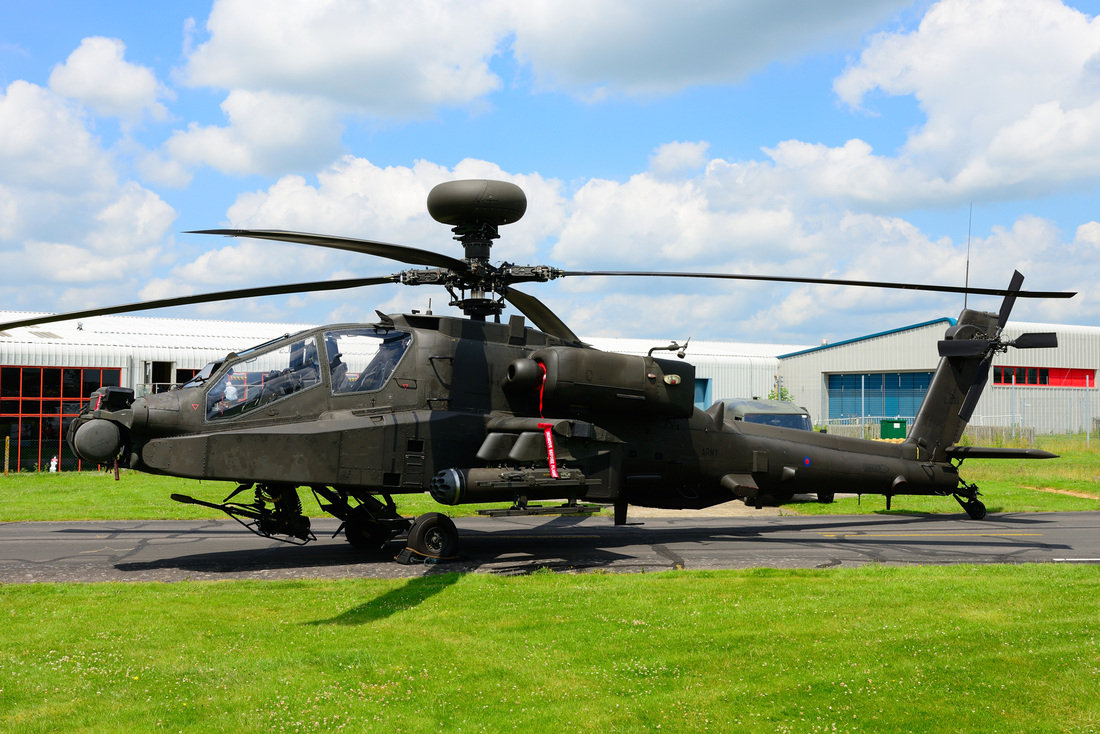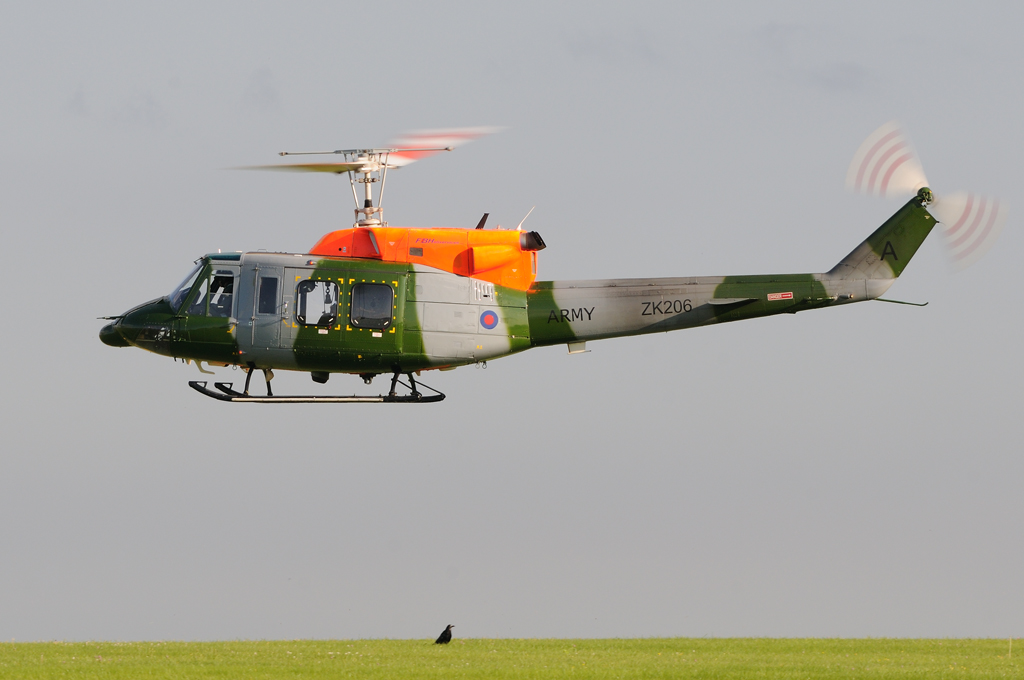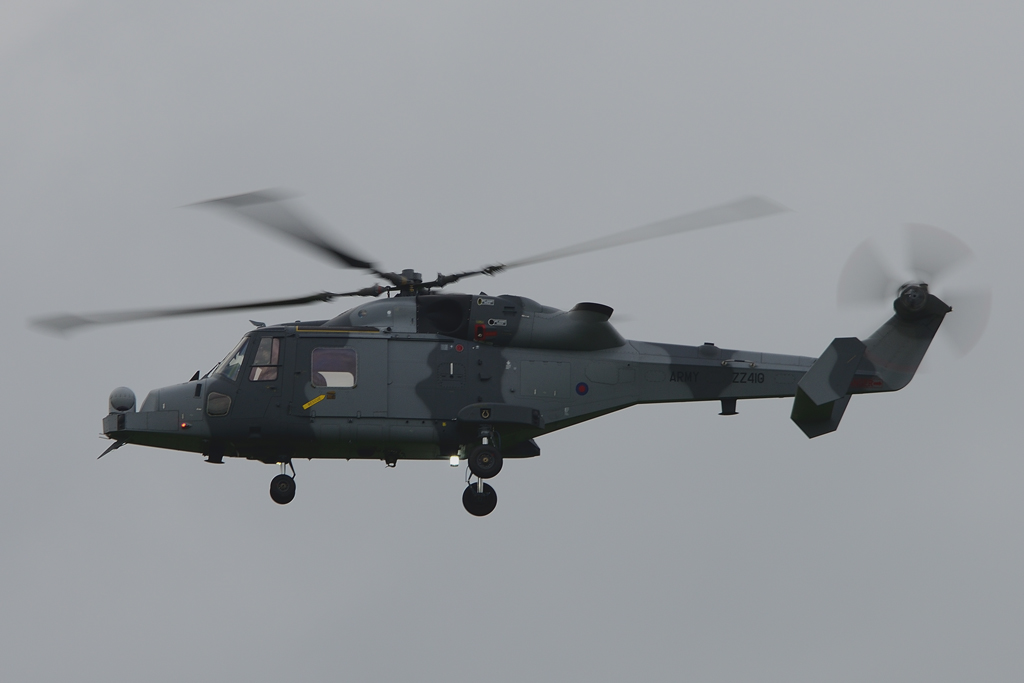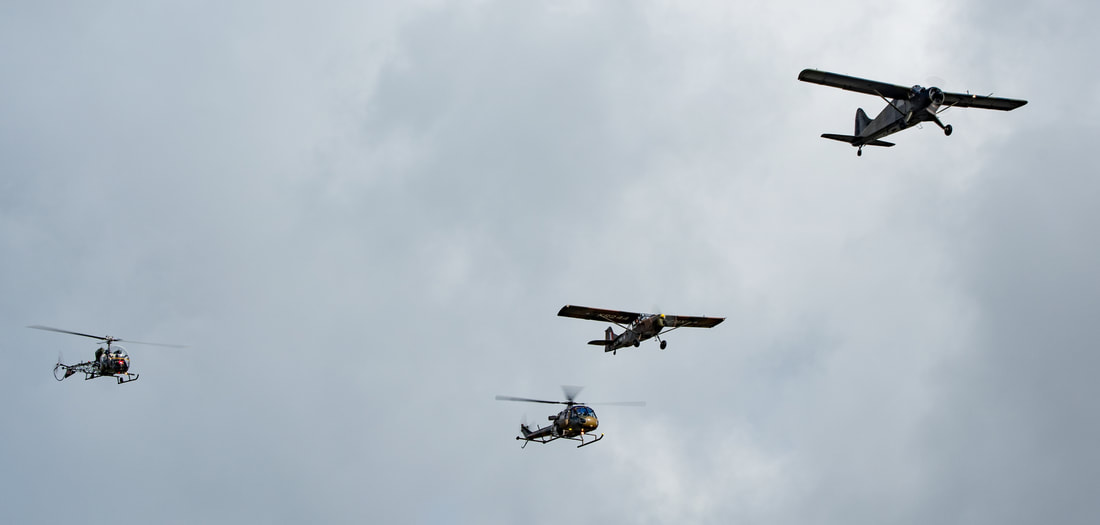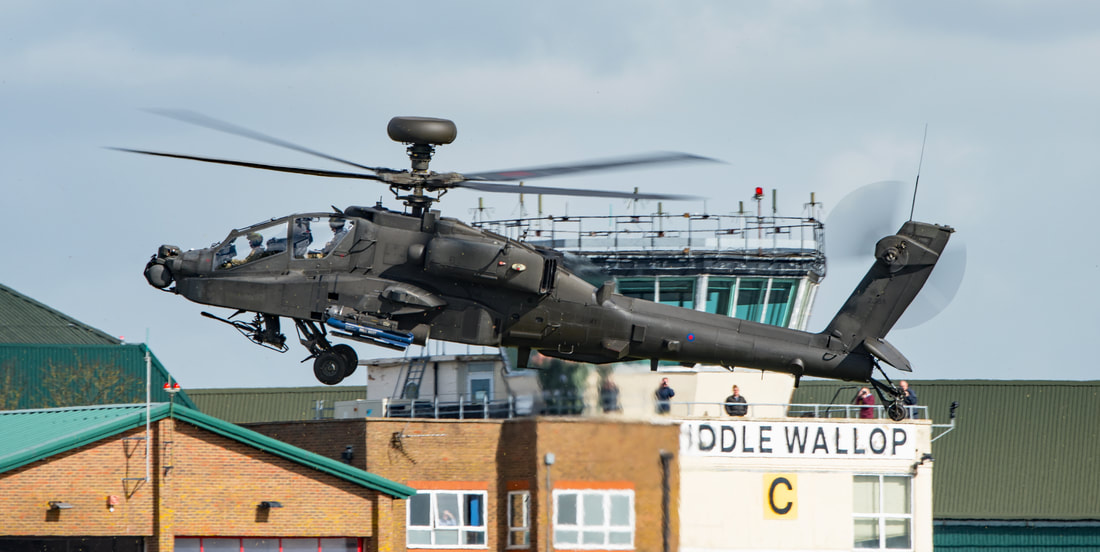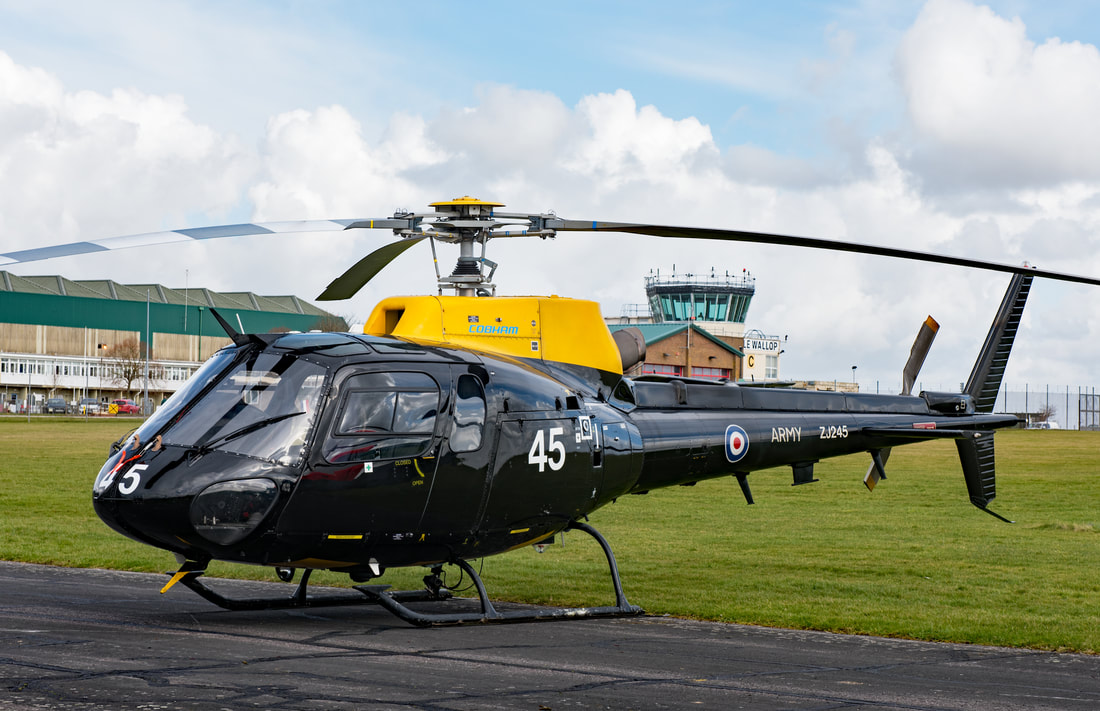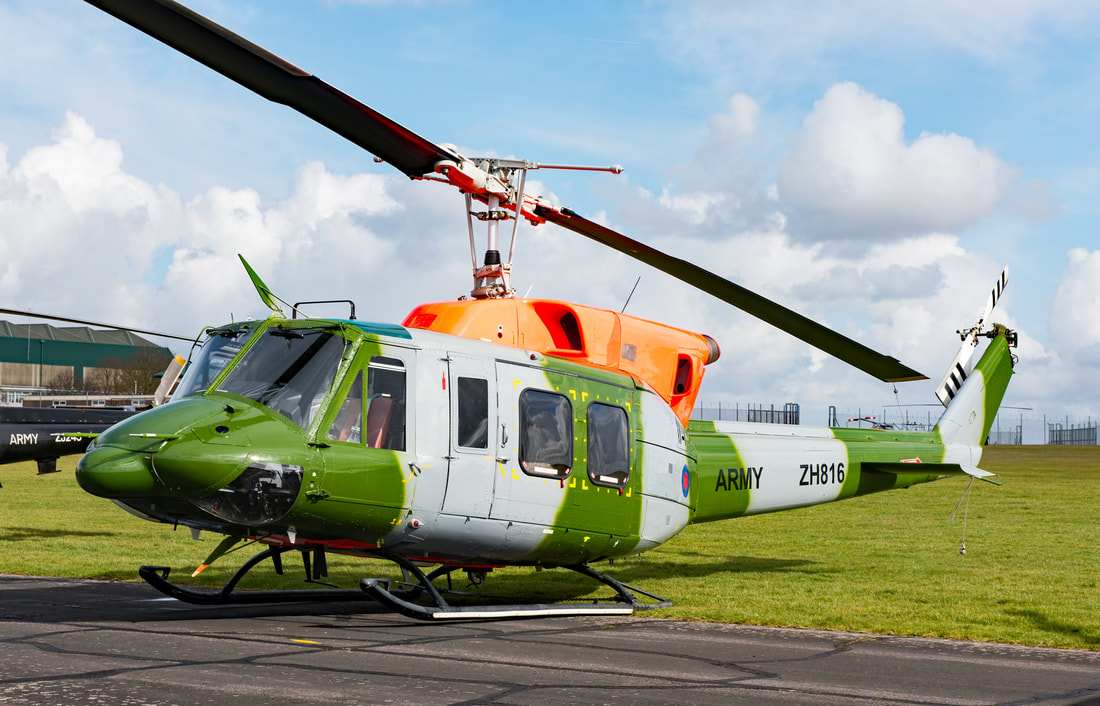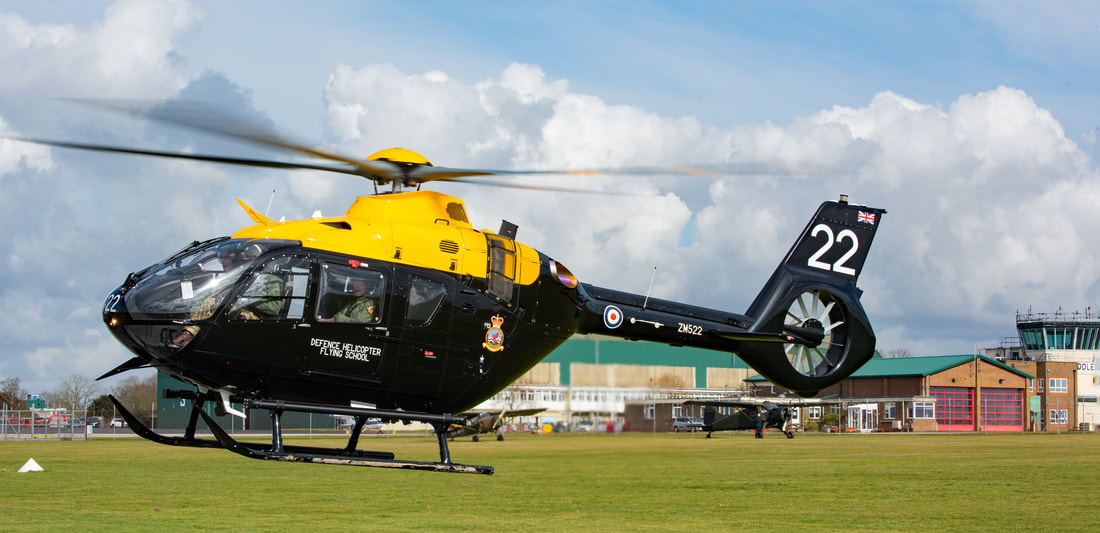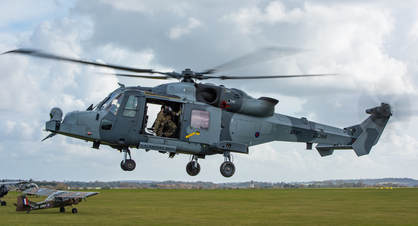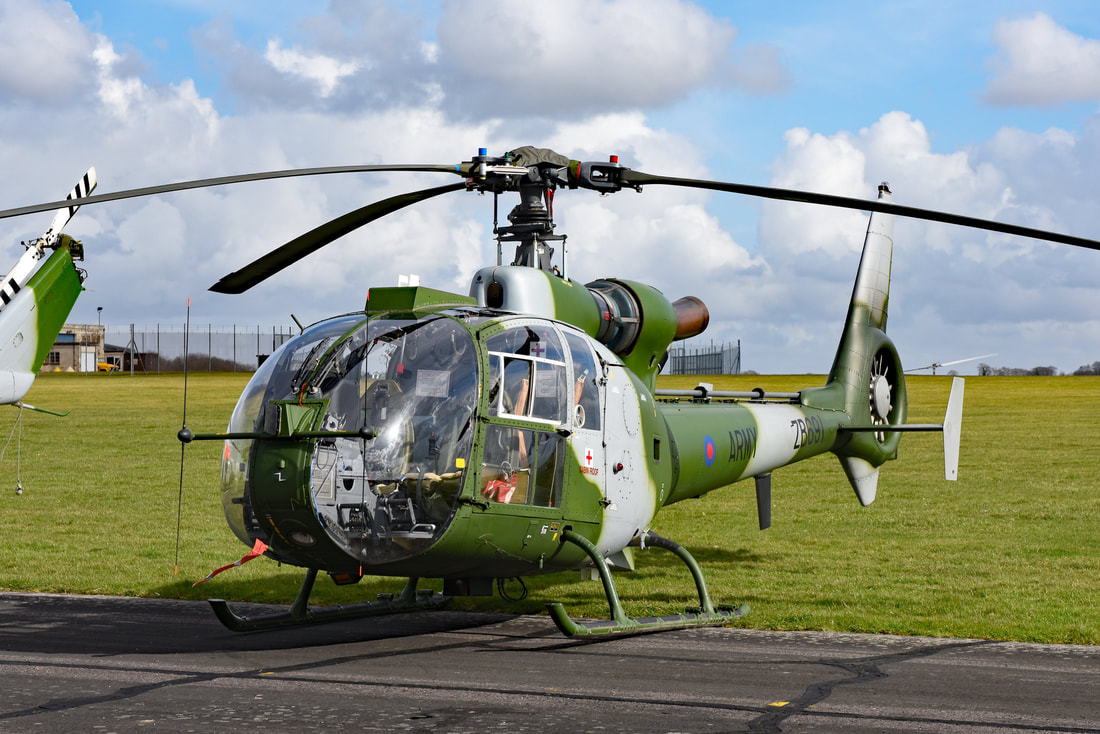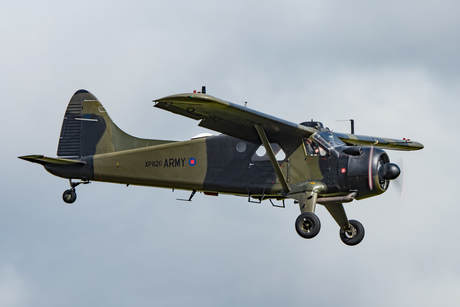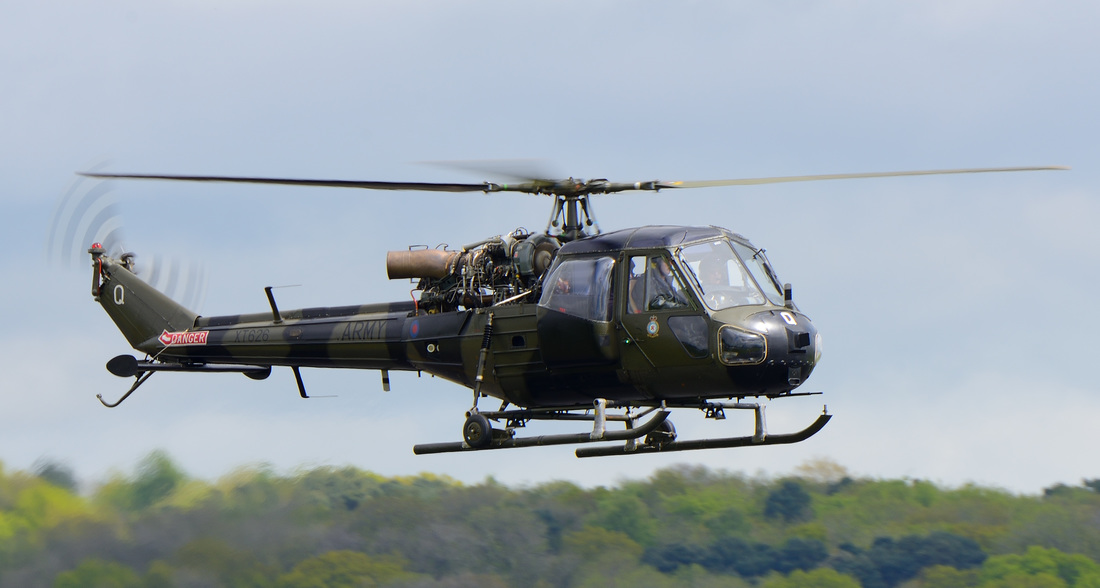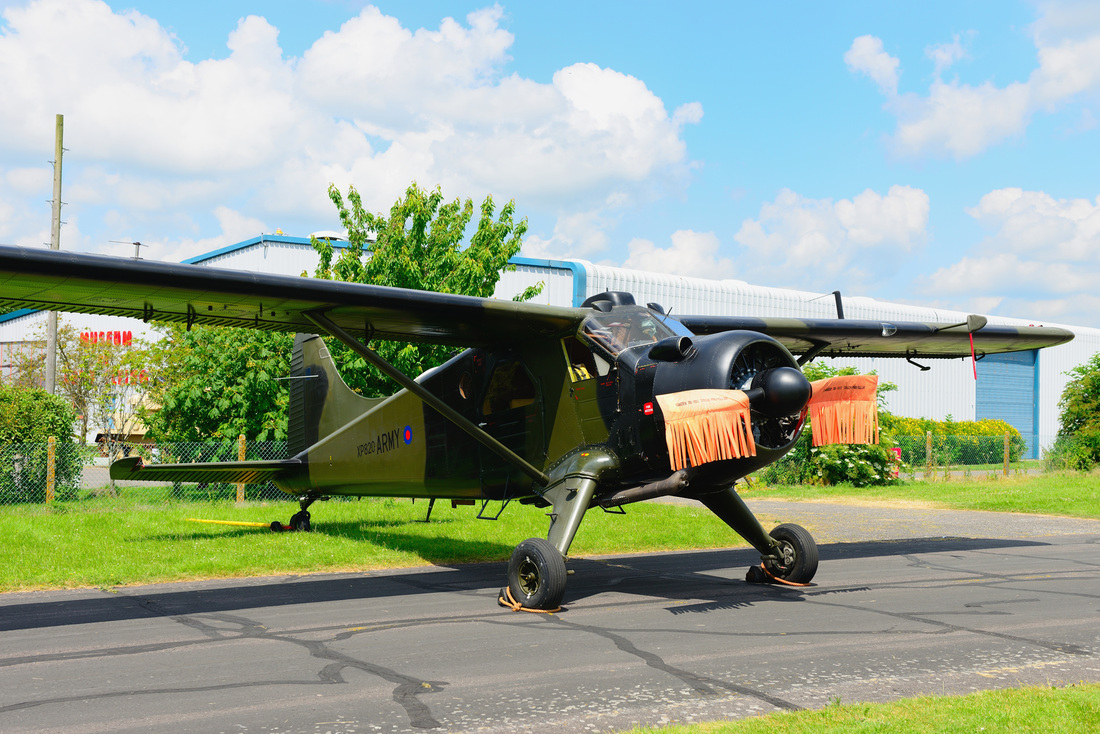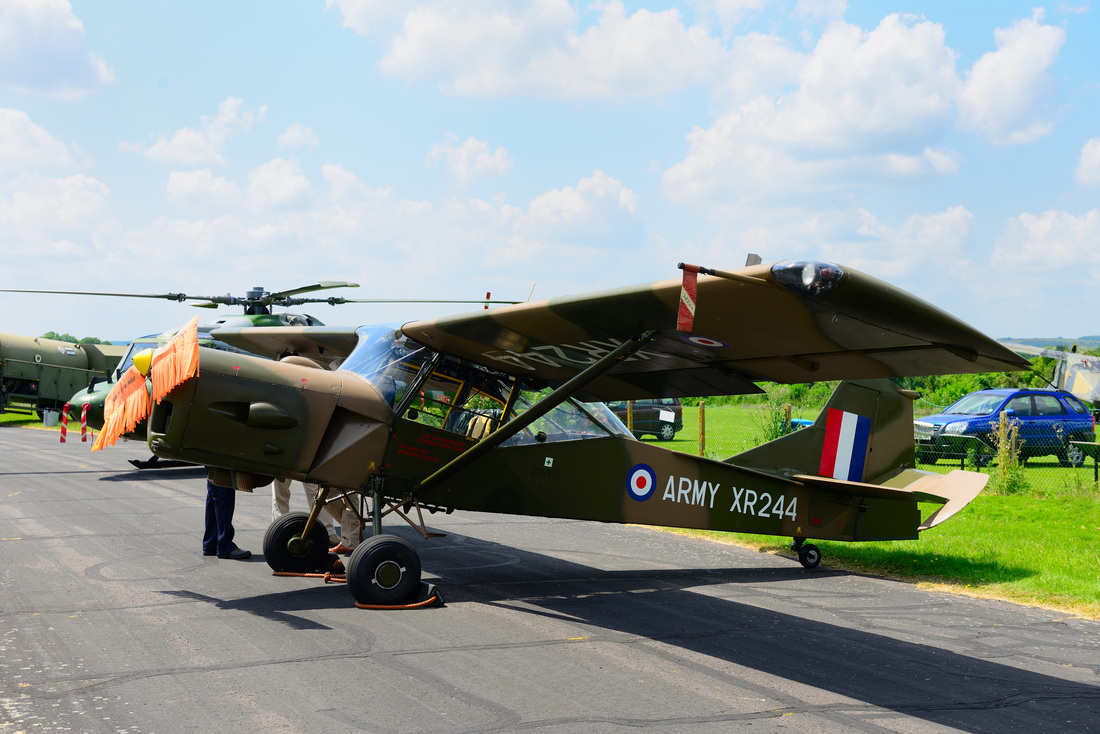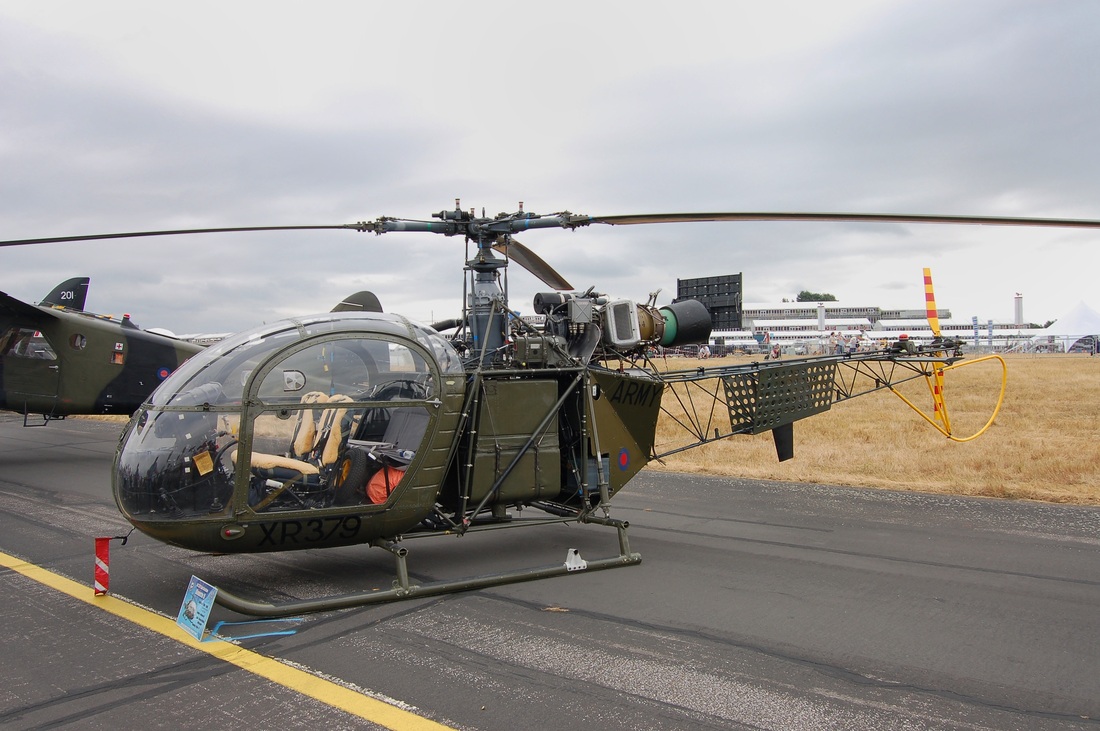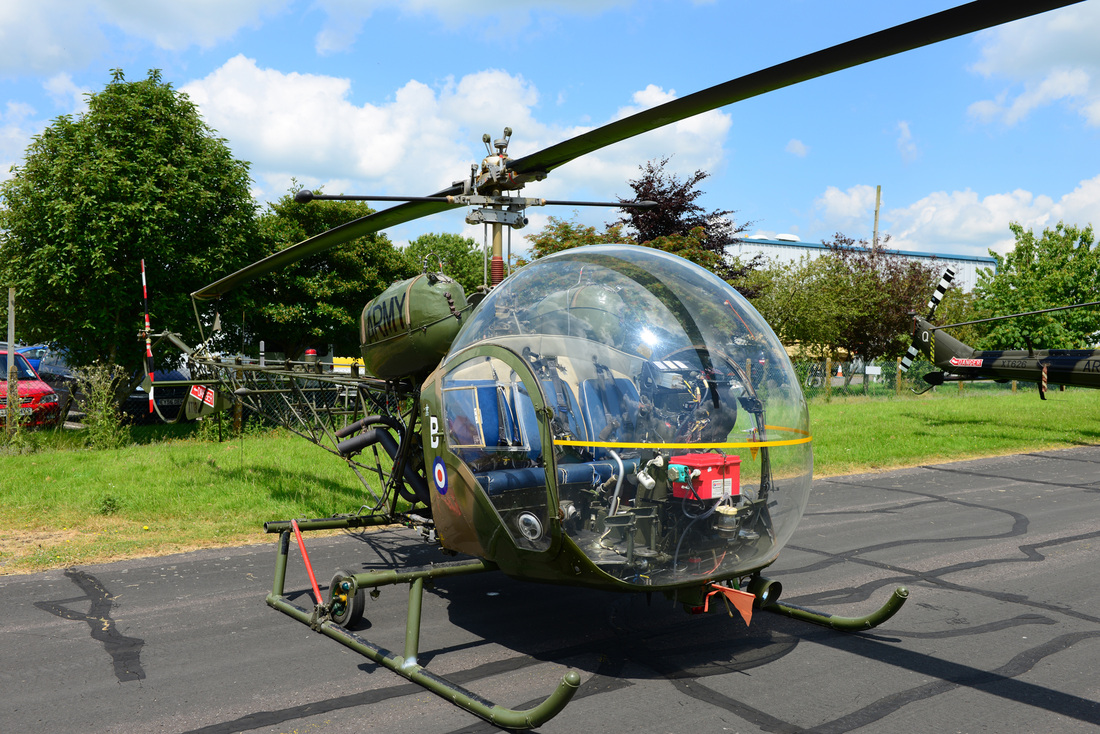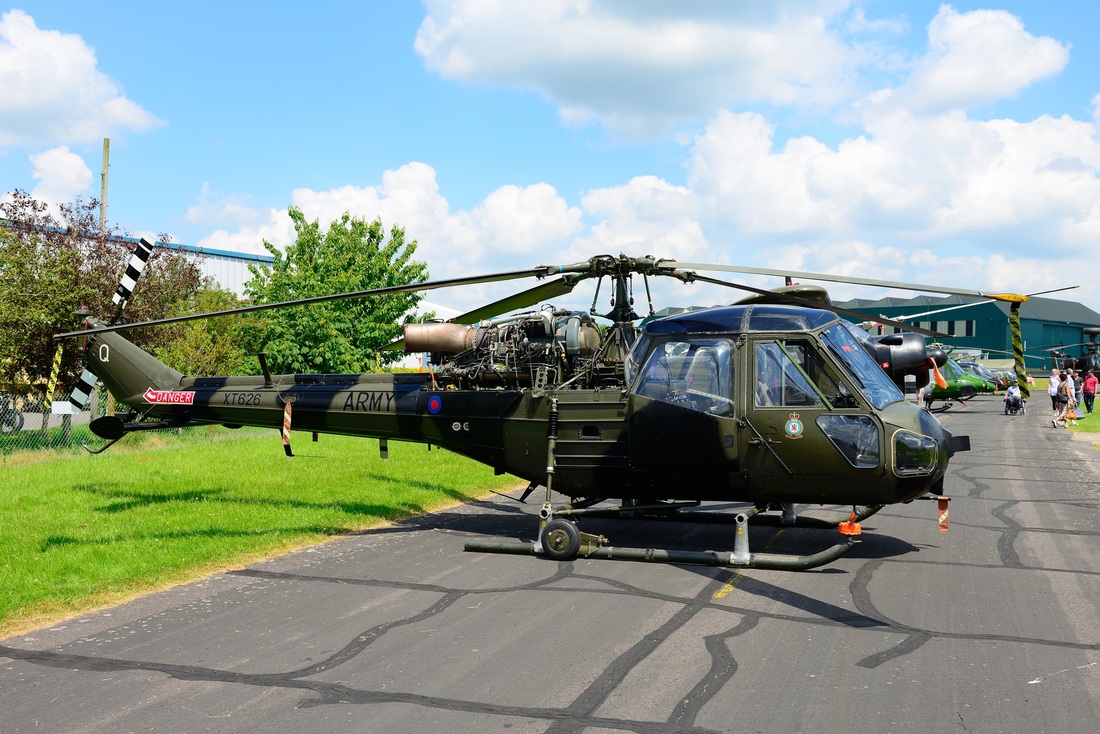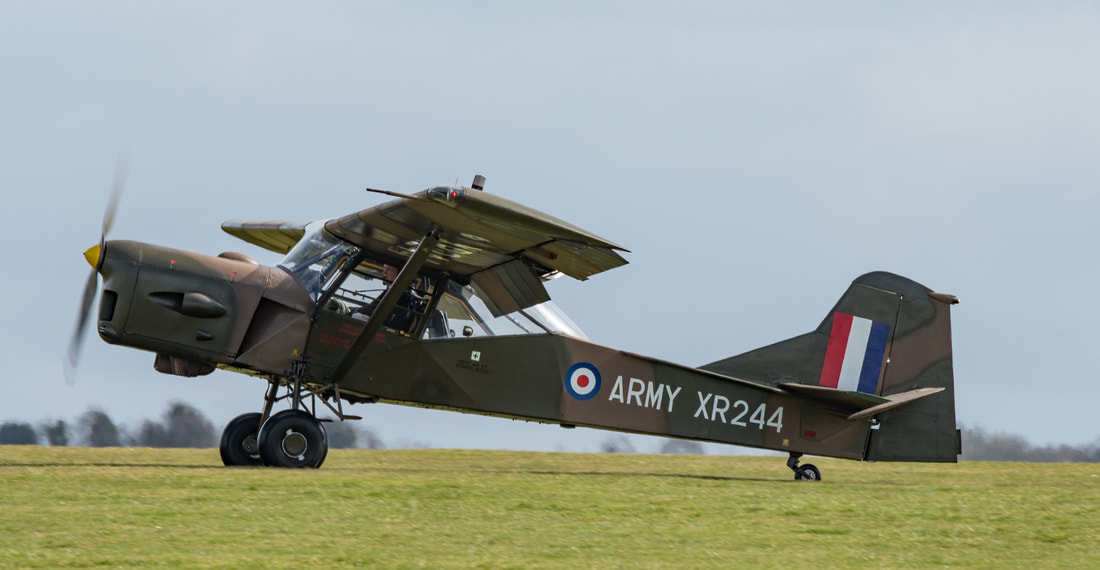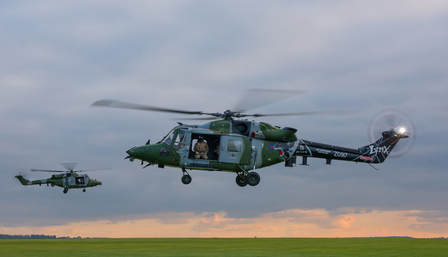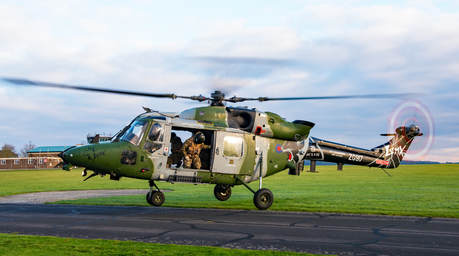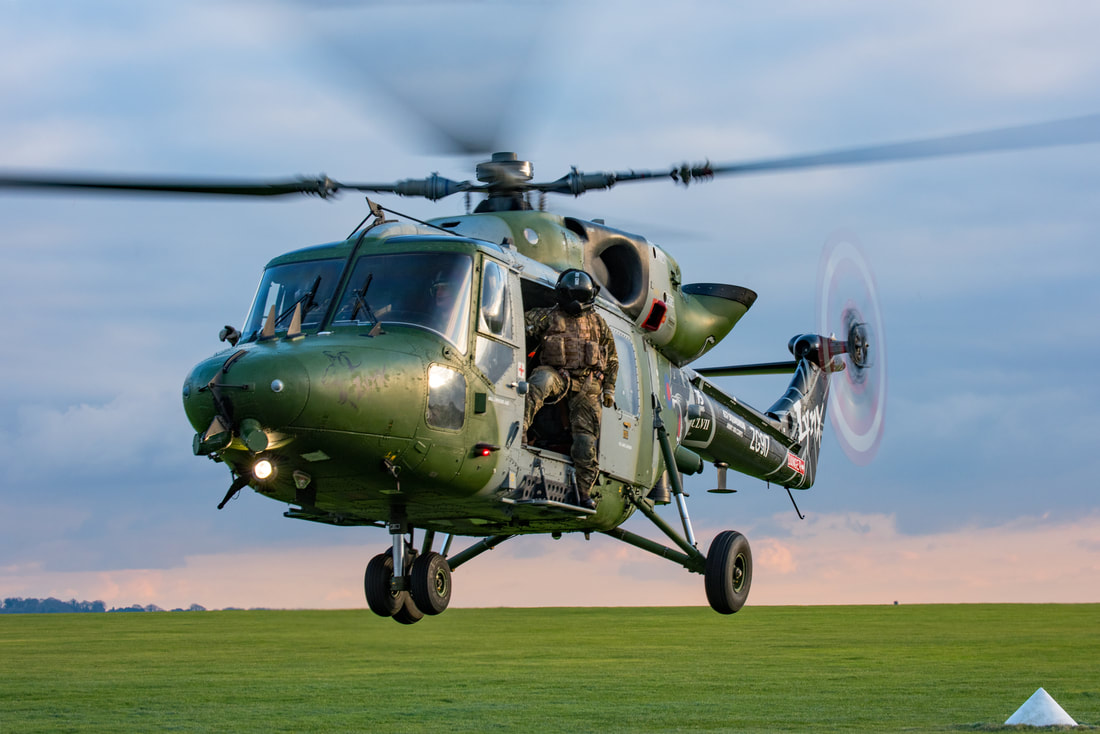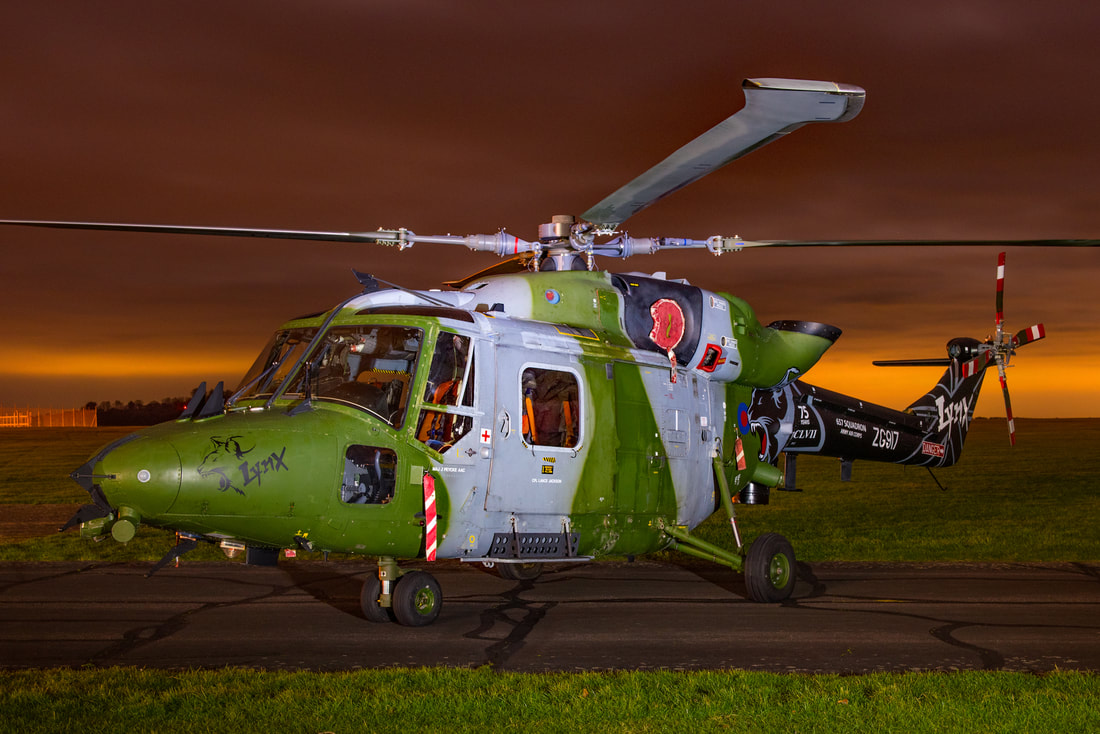Middle Wallop Airfield - History
Written By Richard Hall
When the Second World War began, Middle Wallop was still under construction, but by its end, the airfield had provided a significant contribution to the defence of Britain and the liberation of Europe. Over the years, the base has been used by the RAF, the USAAF, the Royal Navy and today, the Headquarters of the Army Air Corps is located here with a number of flying units.
Located next to the A343 road in Hampshire, Middle Wallop was initially planned to be a bomber station. However, while under construction in April 1940, the airfield's proposed use changed, and it came under the jurisdiction of 11 Group Fighter Command. The airfield itself was of grass with a concrete perimeter track and hardstandings. The landing area measured 1,200 yards (later extended to 1,600 yards) N-S, NE-SW 1,400 yards (later extended to 1,900 yards), E-W 1,250 yards and SE-NW 1,000 yards. Five C Type hangars were also constructed.
Located next to the A343 road in Hampshire, Middle Wallop was initially planned to be a bomber station. However, while under construction in April 1940, the airfield's proposed use changed, and it came under the jurisdiction of 11 Group Fighter Command. The airfield itself was of grass with a concrete perimeter track and hardstandings. The landing area measured 1,200 yards (later extended to 1,600 yards) N-S, NE-SW 1,400 yards (later extended to 1,900 yards), E-W 1,250 yards and SE-NW 1,000 yards. Five C Type hangars were also constructed.
|
Middle Wallop's first occupants were 15 Flight Training School (FTS) flying Airspeed Oxfords and Miles Masters, who were required to vacate Lossiemouth for operational reasons. The Flight initially had a difficult time due to the lack of facilities at the still uncompleted airfield, but by May, training was well underway. At the same time, events in Europe were taking a turn for the worse as the Germans began their advance through France.
|
The British and French Armies were driven back towards the Channel Coast, which led to the eventual evacuation at Dunkirk.
|
On 21 May 1940, Middle Wallop received orders to operate fighters. Shortly after, Hawker Hurricanes of 601 (County of London) Squadron arrived from Tangmere. The unit took part in escort duties to cover attacks by Bristol Blenheim bombers on captured Luftwaffe airfields in France. This was in a bid to slow the Germans advance across the country during Blitzkrieg, which had caught the Allies completely by surprise.
|
No 15 FTS left Middle Wallop on 11 June 1940, and a period of transition took place at the airfield. No 1 (RCAF) Squadron formed in June and spent six weeks training before moving to Croydon. No 238 Squadron also arrived in the same month, again flying Hurricanes to replace 601 who relocated to Tangmere. The squadron was soon in action when 238's Green Section shot down a Messerschmitt Bf110C of 9/ZG76, which force landed at Lulworth on 11 July 1940. One other squadron, 236 of Coastal Command flying Blenheims, also arrived during June 1940, staying until the following July before departing to Thorney Island.
|
During July 1940, 238 was joined by 609 (West Riding) Squadron flying Supermarine Spitfire Is and the Bristol Blenheims of 604 (County of Middlesex) Squadron. In addition, a brief appearance was made at this time by 501 Squadron's Hurricanes, who stayed for three weeks. As a Sector Station, Middle Wallop also had a Section Operations Room located at the airfield. Operating under the Dowding System of Fighter Control, commands were passed out from 11 Group Headquarters at Uxbridge to the individual Sector Stations.
|
Each Sector Station had a number of airfields under its control, with Middle Wallop being located in Sector Y. It was during the Battle of Britain that 11 Group, under the command of Air Vice Marshall Keith Park, bore the brunt of the Luftwaffe's attacks. On 14 August 234 (Madras Presidency) Squadron arrived from St Eval with 609 spending time deployed to the forward operating base at RAF Warmwell. August also saw Middle Wallop transferring to 10 Group.
As the month progressed, the Battle of Britain intensified over Southern England. Many airfields came under attack, and Middle Wallop was not to escape the attentions of the Luftwaffe. On the day that Hermann Goring (Head of the Luftwaffe) launched Adler Tag (Eagle Day), 13 August, the weather in the morning was poor, leading to a postponement of operations until the afternoon. Some crews received the order to stand down but not all, which entailed a number of bombers from KG2 taking to the air. Their fighter escort did know of the cancellation but could not communicate with the bombers who flew on to attack the Coastal Command airfield at Eastchurch and Sheerness, losing five of their Dornier 17s with others damaged in the process. Also not hearing the order to postpone was the Ju88A-1s of I/KG54 and II/KG54, who took off with fighter escort to launch attacks against Farnborough and Odiham, neither of which succeeded. The large enemy formation was intercepted by fighters from 64, 87, 238, 257 and 601 Squadrons, who shot down four Ju88s and one Me 109 and damaged eleven more of the bombers. The cost to the RAF was three Hurricanes shot down with the loss of one pilot, with five others and one Spitfire force landing due to varying degrees of damage. Eagle Day had not got off to a good start for the Luftwaffe.
The official launch of Eagle Day was timed for 14.00hrs, and formations of enemy aircraft were picked at 15.30hrs approaching the South Coast. Ju88A-1s from I, II and III/LG1 escorted by Me110s of ZG2 were tasked to bomb the airfields at Boscombe Down, Worthy Down and Andover, while Ju87s from I/StG1, II/StG2 and StG3 were briefed to attack Warmwell, Yeovil and Portland. The Junkers Ju88A-1s of III/LG1 sought out Andover, which they bombed, causing damage to the station HQ and officer's quarters. One of their number mistakenly dropped its bombs on Middle Wallop, causing damage in the village of Nether Wallop, just behind 238 Squadron's dispersal. Two of the airfield's squadrons, 238 and 609, joined in with the interceptions as the Luftwaffe formations scattered bombs all over Dorset, Wiltshire, Hampshire and Sussex. Operating from Warmwell on this day, 609 caused considerable casualties among the Stukas and their escorts over the Dorset Coast. A large raid was also taking place to the east, with heavy damage inflicted upon Detling in terms of airfield infrastructure and casualties, including the station's CO Gp Capt Davies.
As the day ended and the raids ceased, the RAF had lost 13 aircraft and three pilots, although 47 had been destroyed on the ground. The Luftwaffe, however, lost 47 aircraft and had not achieved much in the way of gaining air superiority. The long war of attrition had begun as the action over the coming days intensified.
For 238 Squadron, the month of August had been hard, and they had suffered losses to both pilots and their Hurricanes. At the end of 13 August, it was decided by Fighter Command that the squadron should be withdrawn from the front line, and they were sent to St Eval in Cornwall to rest and reform, in their place came 234 Squadron. The former were to return to Middle Wallop in September 1940.
As the month progressed, the Battle of Britain intensified over Southern England. Many airfields came under attack, and Middle Wallop was not to escape the attentions of the Luftwaffe. On the day that Hermann Goring (Head of the Luftwaffe) launched Adler Tag (Eagle Day), 13 August, the weather in the morning was poor, leading to a postponement of operations until the afternoon. Some crews received the order to stand down but not all, which entailed a number of bombers from KG2 taking to the air. Their fighter escort did know of the cancellation but could not communicate with the bombers who flew on to attack the Coastal Command airfield at Eastchurch and Sheerness, losing five of their Dornier 17s with others damaged in the process. Also not hearing the order to postpone was the Ju88A-1s of I/KG54 and II/KG54, who took off with fighter escort to launch attacks against Farnborough and Odiham, neither of which succeeded. The large enemy formation was intercepted by fighters from 64, 87, 238, 257 and 601 Squadrons, who shot down four Ju88s and one Me 109 and damaged eleven more of the bombers. The cost to the RAF was three Hurricanes shot down with the loss of one pilot, with five others and one Spitfire force landing due to varying degrees of damage. Eagle Day had not got off to a good start for the Luftwaffe.
The official launch of Eagle Day was timed for 14.00hrs, and formations of enemy aircraft were picked at 15.30hrs approaching the South Coast. Ju88A-1s from I, II and III/LG1 escorted by Me110s of ZG2 were tasked to bomb the airfields at Boscombe Down, Worthy Down and Andover, while Ju87s from I/StG1, II/StG2 and StG3 were briefed to attack Warmwell, Yeovil and Portland. The Junkers Ju88A-1s of III/LG1 sought out Andover, which they bombed, causing damage to the station HQ and officer's quarters. One of their number mistakenly dropped its bombs on Middle Wallop, causing damage in the village of Nether Wallop, just behind 238 Squadron's dispersal. Two of the airfield's squadrons, 238 and 609, joined in with the interceptions as the Luftwaffe formations scattered bombs all over Dorset, Wiltshire, Hampshire and Sussex. Operating from Warmwell on this day, 609 caused considerable casualties among the Stukas and their escorts over the Dorset Coast. A large raid was also taking place to the east, with heavy damage inflicted upon Detling in terms of airfield infrastructure and casualties, including the station's CO Gp Capt Davies.
As the day ended and the raids ceased, the RAF had lost 13 aircraft and three pilots, although 47 had been destroyed on the ground. The Luftwaffe, however, lost 47 aircraft and had not achieved much in the way of gaining air superiority. The long war of attrition had begun as the action over the coming days intensified.
For 238 Squadron, the month of August had been hard, and they had suffered losses to both pilots and their Hurricanes. At the end of 13 August, it was decided by Fighter Command that the squadron should be withdrawn from the front line, and they were sent to St Eval in Cornwall to rest and reform, in their place came 234 Squadron. The former were to return to Middle Wallop in September 1940.
During the afternoon of 14 August, a number of bombers from LG1 were sent to attack targets in southern England. Three Ju88A-1s led by Hauptmann Kern set course for Middle Wallop and, upon their arrival, scored hits on hangars 4 and 5. One of these was 609 Squadron's hangar and offices, which were extensively damaged. Three airmen, Cpl Smith, LAC Thorley and LAC Wilson, were killed while attempting to close the hangar doors, Cpl Appleby was injured and admitted to hospital. Blenheims of 604 Squadron and Spitfires from 609 were also destroyed or damaged in the attack.
|
Some of the squadron's Spitfires did manage to get airborne. One of the Ju88s from I/LG1 that had bombed 609's hangar was caught by Sgt Feary and shot down, crashing at Turf Hill, Charford. Two crew members were killed, with a third injured (died 15 August 1940) and one becoming a POW.
Plt Off Crook damaged a He 111P-4 of KG55 (tasked to bomb Upavon) which was then finished off by Fg Off Dundas (evidence also suggests Sgt Boddington of 234 Squadron was instrumental in shooting down the bomber). |
This aircraft was carrying some high ranking members of the Luftwaffe, three of whom were killed, with two becoming POWs.
On 15 August, the Luftwaffe sent Junkers Ju88A-1s of I/LG1 and II/LG1 from Orleans-Bricy to conduct attacks in the south of England. Messerschmitt Bf110s of II/ZG76 escorted the raid, and despite the constant attention of Hurricanes and Spitfires from 43, 249, 601 and 609 Squadrons over Southampton and the Solent, the raiders of I/LG1 eventually got through. A number of 1,000kg bombs were dropped on Middle Wallop, with further damage caused to two hangars where one aircraft was destroyed and five damaged. Luckily this time, there were no casualties. However, the Luftwaffe did not have things all their own way as Sector pilots claimed thirteen aircraft destroyed plus six probables. No 234 Squadron lost one pilot with two missing. The Ju88s of II/LG1 managed to reach the Fleet Air Arm airfield at Worthy Down, where they released their ordnance but without causing any serious damage. Bombs were also dropped near Odiham again without significant effect. A number of airfields now came under the Wallop sector's control, these being Boscombe Down, Chilbolton and Warmwell.
On 15 August, the Luftwaffe sent Junkers Ju88A-1s of I/LG1 and II/LG1 from Orleans-Bricy to conduct attacks in the south of England. Messerschmitt Bf110s of II/ZG76 escorted the raid, and despite the constant attention of Hurricanes and Spitfires from 43, 249, 601 and 609 Squadrons over Southampton and the Solent, the raiders of I/LG1 eventually got through. A number of 1,000kg bombs were dropped on Middle Wallop, with further damage caused to two hangars where one aircraft was destroyed and five damaged. Luckily this time, there were no casualties. However, the Luftwaffe did not have things all their own way as Sector pilots claimed thirteen aircraft destroyed plus six probables. No 234 Squadron lost one pilot with two missing. The Ju88s of II/LG1 managed to reach the Fleet Air Arm airfield at Worthy Down, where they released their ordnance but without causing any serious damage. Bombs were also dropped near Odiham again without significant effect. A number of airfields now came under the Wallop sector's control, these being Boscombe Down, Chilbolton and Warmwell.
|
On 16 August 1940 Red Section of 249 Squadron was led by Flt Lt John Nicholson from Boscombe Down. In combat with Ju88s and Bf110s, Nicholson won Fighter Command's only Victoria Cross awarded during World War Two.
With his Hurricane I P3576 already in flames after being hit by gunfire from a Bf110, Nicholson was trying to bail out of the stricken aircraft when he saw another Bf110 cross his gunsight. Nicholson stayed in the Hurricane and kept pressing the firing button until the Bf110 was hit and dived away to destruction. |
Only then did he bailout, but his ordeal did not end there, for, on his descent, he was fired at by members of the Home Guard. He was admitted to the Royal Hospital Southampton with slight burns (as stated within ORB).
On 21 August 1940, an intercept was made by 234 Squadron from Middle Wallop, which resulted in a Junkers Ju88A1 of I/KG54 being shot down. The pilots who undertook the interception were Plt Off Bob Doe and Sqn Ldr O'Brien. Doe visited the site of the crash site near the village of Kings Somborne in Hampshire and was horrified when he saw the remains of the crew, who were all killed. An element of mystery surrounds the crash as there appears to be no known burial place for the aircraft's occupants. Their remains were removed from the site in the back of an army truck, but no one seems to know where they went.
On 21 August 1940, an intercept was made by 234 Squadron from Middle Wallop, which resulted in a Junkers Ju88A1 of I/KG54 being shot down. The pilots who undertook the interception were Plt Off Bob Doe and Sqn Ldr O'Brien. Doe visited the site of the crash site near the village of Kings Somborne in Hampshire and was horrified when he saw the remains of the crew, who were all killed. An element of mystery surrounds the crash as there appears to be no known burial place for the aircraft's occupants. Their remains were removed from the site in the back of an army truck, but no one seems to know where they went.
|
Efforts to raise a memorial in the village to the crew after the war did not materialise. However, in the summer of 1951, Mrs Flora Firbank of Hoplands Estate offered her land to erect a small memorial.
This is the memorial we see today, and it is located below the flight path of the Ju88 at the end of its final flight. The memorial is situated approximately two miles away from the crash site and incorrectly dated as the aircraft was shot down on 21 August 1940 at 2.15 pm. Further information regarding the memorial can be found here - Kings Somborne Memorial |
On 11 September 1940, 234 Squadron moved to St Eval. The Battle of Britain continued throughout the summer and autumn, but Middle Wallop did not suffer any further significant attacks. Its fighter squadrons, however, carried on with their interceptions. There were a number of small scale bombing raids, but no major damage was inflicted. The day after 234 moved to Cornwall, A Flight from 23(F) Squadron moved in from Wittering with their Blenheims and began carrying out night interception patrols, without success. The unit appears to have departed by the 25 of the month.
|
As the Battle of Britain turned into a prolonged campaign of attrition, the Luftwaffe started to carry out night bombing of British cities, which became known as the Blitz. While this relieved the pressure on Fighter Command and allowed it to draw breathe, damage to cities was mounting. The RAF at this time did not have an effective night fighting capability. However, research into Air Interception (AI) radar had been taking place, and in September 1940, 604 Squadron received its first AI equipped Bristol Beaufighters. On 20 November 1940, Sqn Ldr John Cunningham, nicked named 'Cat Eyes', which he disliked intensely, undertook the first successful AI interception at night when he and his operator downed a Ju88.
|
No 609 Squadron remained at the airfield until the end of November 1940, after which the unit moved to Warmwell, their place taken by 56 Squadron (Hurricane I), who stayed until December of the same year. No 32 Squadron also brought their Hurricanes in during the last month of 1940, staying until February 1941.
During November and into December, another method of bringing down Luftwaffe night bomber was being trialled at Middle Wallop. No 420 Flight, later 93 Squadron, was formed with the aim of laying parachute mines in the path of enemy bombers. Using Handley Page Harrows, the concept was not very successful as it proved difficult to position mines in front of approaching aircraft. Staying with experimental flying, Middle Wallop saw the formation of 1458 Flight as part of 93 Squadron. Flying Douglas Havocs (the RAF name for a Boston), the aircraft were fitted with powerful searchlights in the nose and known as Helmore Turbinlites. The idea was for the Havoc to pick up the enemy aircraft on its AI radar, track it and then illuminate the target so that an aircraft, such as a Hurricane, could shoot it down.
A similar tactic was used later in the war by the Luftwaffe to counter attacks by Bomber Command. Single-seat fighters known as Wilds Boars (Fw190 and Bf109s) would be directed onto bombers by ground-based searchlights for interceptions to be made. The tactics met with a fair measure of success for the Luftwaffe and, when flown with the radar-guided Tame Boar aircraft (Ju88 and Bf110s), caused considerable losses to Bomber Command aircraft and crews. No 604 Squadron continued to fly night fighter operations, although the delivery of Beaufighters was slow. During the winter period, the Luftwaffe lost 30 bombers making 604 Squadron the highest-scoring unit to date.
During November and into December, another method of bringing down Luftwaffe night bomber was being trialled at Middle Wallop. No 420 Flight, later 93 Squadron, was formed with the aim of laying parachute mines in the path of enemy bombers. Using Handley Page Harrows, the concept was not very successful as it proved difficult to position mines in front of approaching aircraft. Staying with experimental flying, Middle Wallop saw the formation of 1458 Flight as part of 93 Squadron. Flying Douglas Havocs (the RAF name for a Boston), the aircraft were fitted with powerful searchlights in the nose and known as Helmore Turbinlites. The idea was for the Havoc to pick up the enemy aircraft on its AI radar, track it and then illuminate the target so that an aircraft, such as a Hurricane, could shoot it down.
A similar tactic was used later in the war by the Luftwaffe to counter attacks by Bomber Command. Single-seat fighters known as Wilds Boars (Fw190 and Bf109s) would be directed onto bombers by ground-based searchlights for interceptions to be made. The tactics met with a fair measure of success for the Luftwaffe and, when flown with the radar-guided Tame Boar aircraft (Ju88 and Bf110s), caused considerable losses to Bomber Command aircraft and crews. No 604 Squadron continued to fly night fighter operations, although the delivery of Beaufighters was slow. During the winter period, the Luftwaffe lost 30 bombers making 604 Squadron the highest-scoring unit to date.
|
Following on from the great aerial battles of the summer, the autumn of 1940 was quieter at Middle Wallop. In February 1941, a detachment of Boulton Paul Defiant Is of 256 Squadron arrived from RAF Colerne to assist with night fighter operations. On 7 July 1941, the Luftwaffe attacked by moonlight but lost four of their number to 604's Beaufighters.
|
A royal visit by King George VI in the early months of 1941 saw 604 Squadron presented to the monarch. Jimmy Rawnsley, Cunningham's AI operator, was asked by the King, what's your score?, nine replied Rawnsley. Will you get another for me tonight? asked the King. Rawnsley replied, "well, Sir, I will certainly try my best". Later in the evening, Cunningham and Rawnsley were airborne under the control of Starlight (Sopley GCI). The crew were vectored onto a Heinkel He111 with the bomber then appearing on the operator's AI screen. Cunningham closed on the target, and after a brief burst of cannon fire, the bomber went down. At the time of the interception, the crew were informed that the King was observing the unfolding events in Sopley's GCI control room.
|
With Hitler's failure to defeat Britain during the second and first half of 1940 and 1941, his interests turned east, and by June 1941, Operation Barbarossa, the invasion of Russia was underway. This opened up a war on two fronts, which relieved some of the pressure in the west. Middle Wallop's squadrons went from a defensive to an offensive footing and soon took the air war to the Germans in Europe.
In December 1941, 245 Squadron (Northern Rhodesia) arrived from RAF Chilbolton with their Hawker Hurricane IIBs, and they began flying offensive sweeps over France as well as supporting Turbinlite operations. No 604 Squadron continued to operate at night and also added to their score of kills over the Luftwaffe's night bombers. |
During 1942 the RAF continued to take the offensive across the Channel to the Continent. No 1458 Flight struggled on trying to get the Turbinlites to work but without much success. The Defiants of 256 Squadron had left, and those of 245 moved a detachment to Shoreham, although the bulk of the squadron continued to work with the Turbinlites. This role continued until October 1942, when they relocated to Charmy Down. After that, 1458 became 537 Squadron but were disbanded in January 1943 when the results achieved were somewhat less than hoped for.
An aircraft that was to become a legend for its agility and fighting ability was the North American Mustang. Upon entering service initially with the RAF, the performance of the Mustang I was nothing to write home about. Its underpowered Allison engine was found to be wanting at high altitudes, although it proved to be a useful aircraft at lower levels. The first Mustangs arrived in Britain in November 1941, with one of the first operational squadrons, No 16, based at RAF Weston Zoyland. In April 1942, a detachment of the squadron's Mustangs arrived at Middle Wallop for shipping reconnaissance and Army Co-operation roles. Later in the war, when Packard Merlin engines were fitted to the Mustang, it became a world-beater in long-range escort duties for 8th Air Force B-17s and B-24s, as well as a potent dogfighter (but that's another story).
An aircraft that was to become a legend for its agility and fighting ability was the North American Mustang. Upon entering service initially with the RAF, the performance of the Mustang I was nothing to write home about. Its underpowered Allison engine was found to be wanting at high altitudes, although it proved to be a useful aircraft at lower levels. The first Mustangs arrived in Britain in November 1941, with one of the first operational squadrons, No 16, based at RAF Weston Zoyland. In April 1942, a detachment of the squadron's Mustangs arrived at Middle Wallop for shipping reconnaissance and Army Co-operation roles. Later in the war, when Packard Merlin engines were fitted to the Mustang, it became a world-beater in long-range escort duties for 8th Air Force B-17s and B-24s, as well as a potent dogfighter (but that's another story).
|
June 1942 saw more Mustang Is arriving when a detachment from 44 (City of Toronto) Squadron came to the airfield, staying until 1 February 1943 and then relocating to Dunsfold. No 501 (City of Gloucester) Squadron flying Spitfire VCs briefly visited between August and October 1942. Shortly after 504 (County of Nottingham) Squadron arrived with Spitfire VBs converting to VCs before departing to RAF Ibsley in December 1942. |
In the north of the county, RAF Odiham had been home to 400 (RCAF) Squadron, on 27 October 1942, leaving seven of their Mustang Is and fifteen pilots behind on detachment, the unit moved to Middle Wallop. The squadron conducted a number of Rhubarb sorties in their time at the airfield before moving to Dunsfold on 1 February 1943.
|
On 18 November 1942, a Lancaster I, W4118, landed at the airfield with a man at the controls who would become well known the following year. Piloting the aircraft was Wg Cdr G P Gibson from 106 Squadron based at RAF Syerston. Gibson's machine had flown on a raid on the Fiat Works in Turin, but due to fog at Syerston, a diversion was required, and Middle Wallop fitted the bill. Gibson remained at the airfield the following day and in the evening, a party developed in the Mess at which he attended. Gibson remained aloof and tense (probably due to being tired), traits that were not unknown to those who associated with him. As the evening developed, his self-control left him, and he accused the resident night fighter crews of being 'too bloody safe'. The incident was played down, but it did go to show just how much pressure Gibson was under at this point of his operational career. As is well known, Gibson went on to lead the Dams Raid in May 1943 with 617 Squadron, an operation for which he was awarded the Victoria Cross.
|
In December 1942, 604 Squadron left Middle Wallop after a two-and-a-half-year occupancy, which can be considered an exceptionally long time for a squadron to remain at one airfield. During December 406 (Lynx), Squadron RCAF arrived for a three-month stay flying Bristol Beaufighter VI aircraft. During this time, the Beaufighters took the offensive across to the Continent with strikes on targets in France.
|
Early in 1943, more Hurricanes came to Middle Wallop with 164 (Argentine-British) Squadron. The unit flew the IV variant and was soon over the Continent carrying out low-level ground attack sorties. As operations over Europe mounted, Middle Wallop, become steadily more busy with a number of squadrons taking up residence. In February 414 (Sarnia Imperials), Squadron RCAF arrived flying Mustang Is. During March, 19 Squadron flew in with Spitfire VCs and then a very potent ground attack aircraft in the shape of the Hawker Typhoon came to the airfield with 182 Squadron.
|
A second squadron of Typhoons also arrived in March with 247 (China - British) and another RCAF unit, No 456 flying De Havilland Mosquito IIs. Most of the squadrons departed within the month except for 456, who stayed on until August 1943.
Halfway through the year, in June, more Mustang Is flew into Middle Wallop with 169 Squadron. The unit was engaged in shipping reconnaissance, ground and airfield attacks in France and disbanded in September to reform at Ayr later with Mosquitos. The last squadron to arrive was 151, who flew in from RAF Colerne with Mosquito XII night fighters, before returning there in November.
A Period of Change
Between 1940 and 1943, Middle Wallop had been at the forefront of day and night defence of Southern England and also for taking the air war back to the Continent. Things were changing, though, and it closed as an RAF station. In December 1943, the airfield became part of the United States Army Air Force. IX Fighter Command moved into Middle Wallop as its headquarters to control all Ninth Air Force fighter and tactical reconnaissance groups through its IX and XIX Tactical Air Commands. These units were tasked with supporting the US First and Third Armies in the land battles that were to come in the invasion of Europe.
Halfway through the year, in June, more Mustang Is flew into Middle Wallop with 169 Squadron. The unit was engaged in shipping reconnaissance, ground and airfield attacks in France and disbanded in September to reform at Ayr later with Mosquitos. The last squadron to arrive was 151, who flew in from RAF Colerne with Mosquito XII night fighters, before returning there in November.
A Period of Change
Between 1940 and 1943, Middle Wallop had been at the forefront of day and night defence of Southern England and also for taking the air war back to the Continent. Things were changing, though, and it closed as an RAF station. In December 1943, the airfield became part of the United States Army Air Force. IX Fighter Command moved into Middle Wallop as its headquarters to control all Ninth Air Force fighter and tactical reconnaissance groups through its IX and XIX Tactical Air Commands. These units were tasked with supporting the US First and Third Armies in the land battles that were to come in the invasion of Europe.
|
Middle Wallop became known as Station 449, with the 67th Reconnaissance Group (TRG) moving in from Membury. The 107th and 109th Tactical Reconnaissance Squadrons (TRS) were first to arrive, with the 12th and 15th following in March 1944. The units flew Spitfires and P-51B/C Mustangs, taking on the dangerous mission of photographing the planned invasion beaches and their defences in France.
|
The Mustangs were modified to carry an oblique-facing camera behind the cockpit aft of the cockpit. One of the first tasks for the aircraft was to photograph the beaches and coastline for the upcoming planned invasion. In order not to raise German suspicions, the Mustangs flew offshore at a distance of 2,000 yards, at a height of 3,500ft and photographed a 160 mile stretch of coastline and beaches. In all, 83 sorties were flown, and there were no losses despite intense light flak. The 67th TRG was awarded the Distinguished Unit Citation for undertaking this mission, the first for the Ninth Air Force based in the UK.
In May, an exchange took place between the 15th TRS and the 30th Photo Squadron. Based at Chalgrove, the 30th flew its Lockheed F-5 Lightnings to Middle Wallop, with the 15th moving in return late in June. The Lightning gave the 67th high altitude capability.
Also, in June, a new squadron was formed from a Flight within the 109th. This was the 9th Weather Reconnaissance Squadron (Provisional). Their task was to fly ahead of attack forces to report on weather conditions. Flying P-51B Mustangs, their brief was not to engage in dogfights, but flak was ever-present, although losses were light.
After D-Day, airfields became available for the Allies in France. Towards the end of June, the 107th TRS moved to a new base at Deux Jumeaux. On 4 July, the rest of the 67th left Middle Wallop for LeMolay. IX Fighter Command and the other Ninth Air Force units left Middle Wallop, which ended the USAAF's time at the airfield.
In May, an exchange took place between the 15th TRS and the 30th Photo Squadron. Based at Chalgrove, the 30th flew its Lockheed F-5 Lightnings to Middle Wallop, with the 15th moving in return late in June. The Lightning gave the 67th high altitude capability.
Also, in June, a new squadron was formed from a Flight within the 109th. This was the 9th Weather Reconnaissance Squadron (Provisional). Their task was to fly ahead of attack forces to report on weather conditions. Flying P-51B Mustangs, their brief was not to engage in dogfights, but flak was ever-present, although losses were light.
After D-Day, airfields became available for the Allies in France. Towards the end of June, the 107th TRS moved to a new base at Deux Jumeaux. On 4 July, the rest of the 67th left Middle Wallop for LeMolay. IX Fighter Command and the other Ninth Air Force units left Middle Wallop, which ended the USAAF's time at the airfield.
The RAF Returns
The Third Reich had been under heavy attack by RAF and USAAF bombers by night and day during 1943 and 1944. Coupled with the invasion, Hitler needed to find a way to hit back at the Allies. The Luftwaffe was a shadow of its former self and could not launch large-scale attacks against Britain. The Reich had been developing what was to be known as Vengeance weapons. First, there was the V1 flying bomb and then the V2 ballistic missile.
Against the V2, there was no defence as it could not be seen or heard until it had landed and exploded. The V1, however, was a pulse jet-powered unmanned aircraft which could be both seen and heard. The first V1s were launched against London early on 13 June 1944 and caused much concern to the civilian population. It was evident that steps would need to be taken to counteract the menace of the flying bomb. It fell to the RAF and anti-aircraft batteries to put up an effective defence against the weapon. A number of airfields in the South were tasked with 'anti-diver' operations. Middle Wallop became one of them.
The Third Reich had been under heavy attack by RAF and USAAF bombers by night and day during 1943 and 1944. Coupled with the invasion, Hitler needed to find a way to hit back at the Allies. The Luftwaffe was a shadow of its former self and could not launch large-scale attacks against Britain. The Reich had been developing what was to be known as Vengeance weapons. First, there was the V1 flying bomb and then the V2 ballistic missile.
Against the V2, there was no defence as it could not be seen or heard until it had landed and exploded. The V1, however, was a pulse jet-powered unmanned aircraft which could be both seen and heard. The first V1s were launched against London early on 13 June 1944 and caused much concern to the civilian population. It was evident that steps would need to be taken to counteract the menace of the flying bomb. It fell to the RAF and anti-aircraft batteries to put up an effective defence against the weapon. A number of airfields in the South were tasked with 'anti-diver' operations. Middle Wallop became one of them.
|
On 30 July 1944, 125 (Newfoundland) Squadron flew into Middle Wallop for anti diver operations. Flying Mosquito XVII aircraft, a detachment was sent to Bradwell Bay in Essex to take on the V1. Around the same time, 418 (City Of Edmonton) Squadron, also equipped with Mosquito IIs, arrived at the airfield. They stayed for a month, taking on V1s until heading off to Hunsdon. Eventually, the Allies overran the V1s launch sites and firing decreased. As a result, 125 Squadron left Middle Wallop on 18 October, leaving two detachments of anti-aircraft co-operation units in residence.
|
Later in October, Hurricanes returned to Middle Wallop when a detachment from 587 Squadron arrived from Weston Zoyland. Their task was to undertake anti-aircraft flights in co-operation with surrounding gun batteries. Also at the airfield at this time was 3501 Central Servicing Unit, who had arrived from RAF Cranwell. Operations in Europe were at full stretch as the Germans were pushed back, and air power played a significant part. Many aircraft required maintenance and repair, so it fell to 3501 to undertake this element of work. These machines were mainly from the 2nd Tactical Air Force, which included Spitfires, Typhoons, Tempests, Mosquitos and Mustangs were flown to Middle Wallop for work to be carried out. This continued until February 1945, but with the war in Europe near to an end, Middle Wallop was transferred to the Navy and became HMS Flycatcher.
In The Navy
As HMS Flycatcher, Middle Wallop was used to administer and assemble Mobile Naval Air Operations Bases (MONABS). Their purpose was to move on to any existing airfield and provide maintenance and training facilities for aircraft that had flown off aircraft carriers. The site was the Headquarters for MONABS and saw very little flying during their period of occupation. There was also a reserve aircraft storage facility for use by Worthy Down. Mosquito B XXVs destined for the Navy were taken on charge here, and 700 Squadron performed Maintenance Test Pilot training until moving to Yeovilton in April 1946, after which Flycatcher was returned to Fighter Command.
The RAF Returns (again)
Following the departure of the Navy, the RAF returned in April 1946 with a squadron who were previously based at Middle Wallop. No 164 (Argentine-British) Squadron flew to the airfield with their Spitfire IXs. The unit converted to Spitfire LF XVIe in July before disbanding to become 63 Squadron in August. They left in September of the same year.
On 3 June 1946, Spitfire IXs of 165 (Ceylon) Squadron flew to the airfield to practice formation flying in preparation for a Victory Day flypast, which took place on the 8 June over London and the Home Counties. They returned briefly in July 1946 to take part in an exercise named Ramrod 25.
Also deploying to the site was 80 Squadron who flew their Hawker Tempests in during May 1947 for a brief period. They participated in a demonstration at Westdown Ranges for the School of Land/Air Warfare before returning to their home base at Wunstorf in Germany.
In The Navy
As HMS Flycatcher, Middle Wallop was used to administer and assemble Mobile Naval Air Operations Bases (MONABS). Their purpose was to move on to any existing airfield and provide maintenance and training facilities for aircraft that had flown off aircraft carriers. The site was the Headquarters for MONABS and saw very little flying during their period of occupation. There was also a reserve aircraft storage facility for use by Worthy Down. Mosquito B XXVs destined for the Navy were taken on charge here, and 700 Squadron performed Maintenance Test Pilot training until moving to Yeovilton in April 1946, after which Flycatcher was returned to Fighter Command.
The RAF Returns (again)
Following the departure of the Navy, the RAF returned in April 1946 with a squadron who were previously based at Middle Wallop. No 164 (Argentine-British) Squadron flew to the airfield with their Spitfire IXs. The unit converted to Spitfire LF XVIe in July before disbanding to become 63 Squadron in August. They left in September of the same year.
On 3 June 1946, Spitfire IXs of 165 (Ceylon) Squadron flew to the airfield to practice formation flying in preparation for a Victory Day flypast, which took place on the 8 June over London and the Home Counties. They returned briefly in July 1946 to take part in an exercise named Ramrod 25.
Also deploying to the site was 80 Squadron who flew their Hawker Tempests in during May 1947 for a brief period. They participated in a demonstration at Westdown Ranges for the School of Land/Air Warfare before returning to their home base at Wunstorf in Germany.
In January 1948, Middle Wallop was still an RAF station, but it also became home to the Air Observation Post training organisation. The unit was initially known as 227 OCU but was renamed the AOP School in May 1950. The flying element became known as the Light Aircraft School.
|
Fighter Controller training also came to Middle Wallop with the Fighter Command Control and Reporting School moving in during January 1948.
Flying Spitfire LF XVI and Oxford aircraft, the unit became 288 Squadron with conversion onto Boulton Paul Balliol T.2s in May 1953. In March 1954, the first steps were taken into the area of aviation that Middle Wallop is best known for today, helicopters. |
The Army Air Corps
Military helicopters first started to appear towards the end of World War Two, and in 1946 the army recognised their potential. No 657 Flight was formed and was equipped with Sikorsky R-4B Hoverfly helicopters. The aircraft were trialled in the AOP role with a measure of success. However, the Hoverfly was far from adequate due mainly to the shortage of spare parts, and the flight soon disbanded. In 1950 another flight was formed, this time with Bristol Sycamore helicopters and further trials were undertaken.
Rotary wing flying came to Middle Wallop with the Helicopter Development Flight (CFS) forming in March 1954 with Westland Dragonfly aircraft. The Joint Experimental Helicopter Unit formed a year later. On 1 September 1957, the Army Air Corps (AAC) was created with the airfield officially transferred to the army on 1 October 1958. The AAC was formed by merging Air Observation Post Squadrons and Light Liaison Flights.
The AAC's role was to provide observation, reconnaissance, fire control, liaison and the movement of men and materials. Pilots came initially from the Glider Pilot Regiment with technical staff trained by REME, in turn replacing RAF personnel.
The Elementary Training Flight (ETF) formed flying Austers and Chipmunks to undertake fixed-wing flying training. The ETF later became the Basic Fixed Wing Flight when helicopter training commenced. In later years primary helicopter and Chipmunk training was contracted out to Bristow while military conversion and operational flying remained with the army.
The AAC's role was to provide observation, reconnaissance, fire control, liaison and the movement of men and materials. Pilots came initially from the Glider Pilot Regiment with technical staff trained by REME, in turn replacing RAF personnel.
The Elementary Training Flight (ETF) formed flying Austers and Chipmunks to undertake fixed-wing flying training. The ETF later became the Basic Fixed Wing Flight when helicopter training commenced. In later years primary helicopter and Chipmunk training was contracted out to Bristow while military conversion and operational flying remained with the army.
Throughout the 1960s and 70s helicopter design progressed and many varied types were seen at Middle Wallop. including - (all photos - Richard Hall)
The Modern Day Army Air Corps
Since World War Two, the British Army has been involved in many small and large scale conflicts. These have included Malaya, Korea, Suez, Northern Ireland, The Falklands, The Gulf War, The Balkans and more recently, Iraq and Afghanistan. Airpower has been used extensively with helicopters very much in evidence.
The modern-day AAC has continued to evolve, and today its headquarters is located at Middle Wallop. This also includes the AAC's Regimental Headquarters and the Corps operational support units.
Middle Wallop is also home to the Army Aviation Centre, which consists of the following units,
(correct at time of writing 2017) -
No 2 (Training) Regiment AAC
No 7 (Training) Regiment AAC
The modern-day AAC has continued to evolve, and today its headquarters is located at Middle Wallop. This also includes the AAC's Regimental Headquarters and the Corps operational support units.
Middle Wallop is also home to the Army Aviation Centre, which consists of the following units,
(correct at time of writing 2017) -
No 2 (Training) Regiment AAC
- 676 Squadron Army Air Corps - providing training support to Phase 2 AAC groundcrew
- 668 (Training) Squadron Army Air Corps who deliver the training for groundcrews in rearming, refuelling and ground handling of Westland AH-64 Apache attack helicopters
- No 25 Flight AAC - In August 2011, the Flight relocated from Belize to Middle Wallop. Flying Bell 212 helicopters, the Flight's role was to assist UK Land Forces, including participating in support of the 2012 Olympics. In March 2013, the Flight relocated to Kenya to support British Army Training Unit Kenya (BATUK).
No 7 (Training) Regiment AAC
- 670 Squadron Army Air Corps is responsible for the Operational Training Phase of the Army Pilots Course.
- 671 Squadron Army Air Corps conducts Conversion to Type training on Gazelle and Bell 212 aircraft for graduates of the Operational Training Phase and students on the Aviation Crewman course alongside Conversion to Role training for the Lynx Wildcat. The Squadron also provides training for the Aviation Crewman specialism.
- 673 Squadron Army Air Corps conducts Conversion to Type training on the Apache aircraft for experienced Army pilots and the newly qualified, who then go on to their respective regiments to complete their combat training.
(All photos - Richard Hall)
Middle Wallop is located near Salisbury Plain Training Area (SPTA), and many of its helicopters can be seen out in the countryside conducting various exercises and training flights. Link to SPTA - please, if you do go out on the Plain to watch the helicopters, ensure you follow all rules and do not hinder or obstruct the aircraft when they are training.
Training Ends
On 16 March 2018, the final Wings Parade was held at Middle Wallop before AAC training moves to the Defence Helicopter Flying School at RAF Shawbury. The last pilots to qualify received their wings from Prince Harry, and the occasion was marked by a flypast from the Historic Aircraft Flight Trust, an Apache and two Squirrels. On the ground, a number of helicopters were also on display to show the types used by the AAC at Middle Wallop over the years and decades. Click on images to enlarge.
Army Historic Aircraft Flight
The Army Historic Aircraft Flight (AHAF) is also located at Middle Wallop. Initially formed in 1980, the purpose of the Flight is to preserve and maintain one of each type of aircraft flown by the AAC since its formation in 1957.
Funding for AHAF came from the MoD, donations and income from airshow appearances. The Flight has been in a state of suspended animation recently due to official funding being withdrawn. To ensure that the Flight remains viable and to reduce costs, five of the aircraft (Beaver, Auster, Alouette, Sioux and Scout) have been gifted to the Historic Aircraft Flight Trust (HAFT) and placed upon the civilian register.
The Army Historic Aircraft Flight (AHAF) is also located at Middle Wallop. Initially formed in 1980, the purpose of the Flight is to preserve and maintain one of each type of aircraft flown by the AAC since its formation in 1957.
Funding for AHAF came from the MoD, donations and income from airshow appearances. The Flight has been in a state of suspended animation recently due to official funding being withdrawn. To ensure that the Flight remains viable and to reduce costs, five of the aircraft (Beaver, Auster, Alouette, Sioux and Scout) have been gifted to the Historic Aircraft Flight Trust (HAFT) and placed upon the civilian register.
|
The UK's airshows have missed seeing these historic aircrafts participation over the past couple of years, but the future now looks a lot brighter. On 3 May 2015, Abingdon's Air and Country Show saw HAFT's Scout AH.1 XT626 arrive at the event to take up a place in the static display area. It is hoped this will be the first of many such appearances by the Flight's aircraft in the coming years so that we can all hear and see these historic airframes in action.
|
The aircraft flown by the Flight are as listed below -
- XR244 - Auster AOP Mk9
- XP820 - De Havilland Beaver AL Mk1
- WD325 - De Havilland Chipmunk T10
- XT131 - Agusta-Bell Sioux AH Mk1
- XT626 - Westland Scout AH Mk1
- XL812 - Saunders Roe Skeeter AOP Mk12 (static display only)
- EM820 - de Havilland Tiger Moth DH82A (static display only)
The Last of the Lynx
During the afternoon of 26 January 2018, two Lynx AH.9As left RAF Odiham and, after a short flight around some local haunts, flew to Middle Wallop for disposal. The two Lynx were ZG885 and ZG917, and this was the very last flight for the helicopter, which has been in service with the Army Air Corps in various marks for nearly 40 years. ZG917 was the last to touch down, and the opportunity was given for the helicopter to be photographed as darkness fell.
A gala dinner marked the retirement in honour of the Lynx. This was held during the evening at Middle Wallop, with many who had an association with the helicopter in attendance. Middle Wallop has had a long involvement with the Lynx, so it was very appropriate that the last flight of the type took place on very familiar ground.
Link To The Museum Of Army Flying
Return To Home Page
Sources -
Return To Home Page
Sources -
- The Battle Of Britain Then & Now - After The Battle
- Wreck & Relics 24th Edition - Ken Ellis
- Action Stations No 5 - Military Airfields Of The South West - Chris Ashworth
- Hampshire Airfields In The Second World War - Robin J Brooks
- UK Airfields Of The Ninth Then And Now - Roger A Freeman
- Guy Gibson - Richard Morris
- www.army.mod.uk
